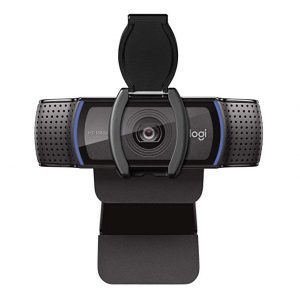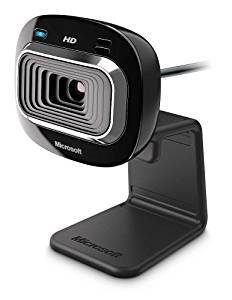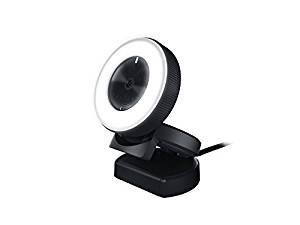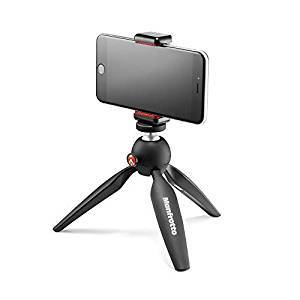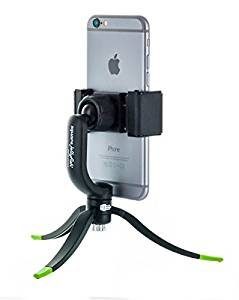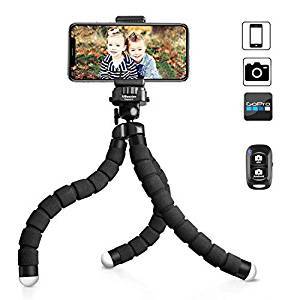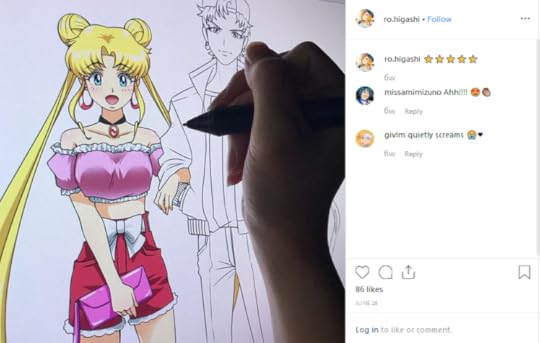Cory Huff's Blog: The Abundant Artist Goodreads blog, page 10
November 22, 2019
TAA Black Friday 2019 Deals
Last year we did a roundup and it was so popular we’re bringing it back! We are collecting some of the best Black Friday deals that are artist-specific. This is a heads-up to look out for Friday.
How to Sell Your Art Online 101
Our flagship course, How to Sell Your Art Online 101, will be available on Black Friday, November 29 and again on Cyber Monday, December 2, at a 25% discount. Normally $400, the course will be just $300 for those two days only.
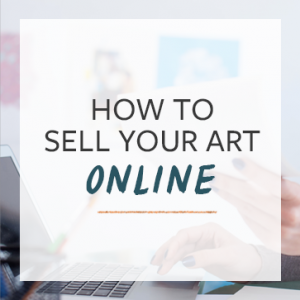
Please note: this is early access for the January 2020 cohort. You will have access to the course materials immediately, but the coaching calls will begin on January 13, 2020.
Divi WordPress Theme
One of my favorite companies, Elegant Themes, is doing a week-long giveaway where you can win things like a brand new iMac just for entering, and their Divi theme is the best WordPress theme on the market.
If you are looking to build a WordPress website for yourself, we’ve recommended Divi for years (I use it for several sites – here’s our review). Now they’re offering 25% off on Friday, and a bunch of cool goodies. Check out the Divi Black Friday page (affiliate link).
There’s a few more on the horizon. We’ll have a longer run-down on Friday, including Black Friday deals on several of our favorite books and other resources.
If you use WordPress, you’ll need hosting. Bluehost is having a huge sale. You can get web hosting for as little as $2.95 per month if you pay for a year in advance. Here’s the link.
Other Tools & Supplies
For Digital Artists, the iPad Pro can be had at a substantial discount at Best Buy for $524.99. MacRumors has a comprehensive list of Apple discounts at this link. https://www.macrumors.com/roundup/black-friday/
Michael’s craft store has 40% off all regular priced items from noon to 10 on Friday and a bunch of great deals. Lots of artists recommended this sale.
Email Marketing Service: ConvertKit. Our recommended email marketing service, ConvertKit, is offering a full year subscription at the price of just 9 months. You have to be on their list. http://mbsy.co/convertkit/20835474
Check our Tools & Resources page. We have a page with all of our recommended resources. You might check that page to see if any of those companies are offering Black Friday discounts.
What Else You Got?
Got a Black Friday / Cyber Monday deal you want everyone to know about? Comment here and let us know before Wednesday morning so we can include it in Friday’s email.
The post TAA Black Friday 2019 Deals appeared first on Online Marketing for Artists.
November 11, 2019
How Artists Use Instagram for Ephemeral Marketing
Open Instagram, and the first thing to catch your eye is the bubbles at the top of the screen. The accounts you follow are encircled in orange and purple, notifying you that there are new stories to watch. First appearing in 2016, the stories feature allows users to share images, videos, text, and gifs for 24 hours before the content “disappears” (although there is also a handy Highlights feature that allows you to save your stories and post them to your profile… so they won’t truly disappear if you don’t want them to.)
Perhaps you’ve never created an Insta Story before, or perhaps you’re a little addicted to them. The fact remains… they work. But what is it about disappearing content that is so appealing, and how can an artist harness the mystique of ephemeral marketing to improve their business? Let’s take a look at what ephemeral marketing is, why it works, and some artists who are using it for their benefit.
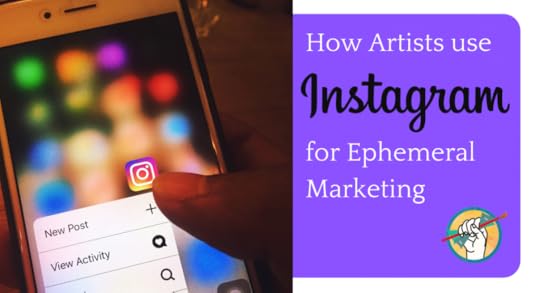
Ephemeral Marketing
Ephemeral marketing is a fancy way of saying “content that disappears”. The pioneer of this kind of media is Snapchat. Founded in 2011, the company is the first social media platform to introduce a way of sharing videos and pictures that disappear after 24 hours. Instagram quickly followed suit, as did Facebook (which has owned Instagram since 2012, thus the marked similarity in FB & IG stories).
Why does ephemeral marketing work?
Ephemeral marketing appears at one end of what we might imagine as a spectrum of social media marketing tactics. On the other end is viral videos, which are shared thousands or even millions of times, and which you’re likely to see multiple times across multiple platforms over the course of several days or weeks. While a viral video can be wildly successful in the short term, it also burns itself out. By the end of its “shelf-life”, so to speak, by which time it has likely been riffed on, parodied, and analyzed into the ground, everyone is tired of talking about it.
Ephemeral marketing, by contrast, cannot be easily shared, and a short shelf life is built in from the beginning. The goal of ephemeral marketing is not to spread like a virus, but rather to inspire a sense of exclusive access; it taps into that peculiar and ubiquitous state of mind known as FOMO (fear of missing out).
Another distinct advantage to ephemeral marketing is the sandbox-like nature of the platform that allows companies and brands to try new things and make mistakes without the more permanent imprint of a conventional marketing campaign. Granted, one can still screenshot a story if there is a particularly cringeworthy gaffe involved, but the fact that ALL content disappears, even the really good stuff, helps prevent the greater scandal of quickly deleting an ad that didn’t go over well. According to destinationcrm.com, “For content marketing consultant and author Kate Talbot, “the ability to share your daily life in a way that is authentic and true to yourself without it affecting your overall social media aesthetic is very much why disappearing content has become so popular.””
People use Instagram stories for a wide variety of storytelling methods. The platform opens up a wide realm of creative possibilities. A story can be a static image, text on a colorful background, or short snippets of video.
Artists Doing Cool Things on Instagram Stories
@popartpuppydogs
We did a case study on Jessica Marie of Pop Art Puppydogs where she shared a bit about her journey (see the full case study here: Jessica Maria, Pop Art Puppydogs: A Case Study).
Jessica uses Instagram stories to document her appearances at art shows and other events, starting with a countdown several days before the event and including daily posts to build excitement. Jessica includes a lot of cross-promotion in her stories, tagging the accounts of dogs she’s featured as well as sharing whenever she is featured on someone else’s account. You’ll notice that among successful Instagram users, cross-promotion in stories in common.
Here Jessica uses a very clever way to make sure that her audience comes back the next day to see the big reveal:
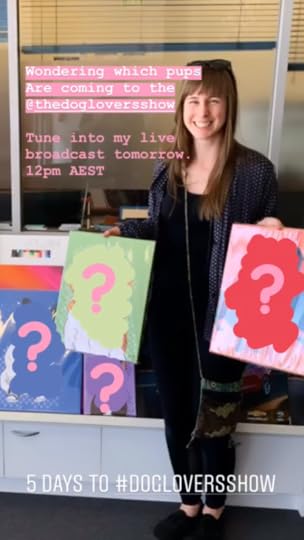
Jessica builds more interest in her upcoming show with a daily countdown, and providing her fans something they love to see- a side-by-side of the dog and the portrait:
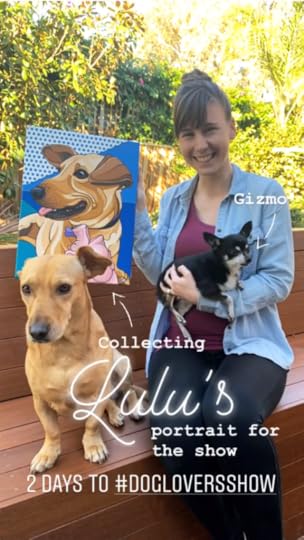
She shares every part of the process, so viewers of her stories feel invested and included in what she’s doing:
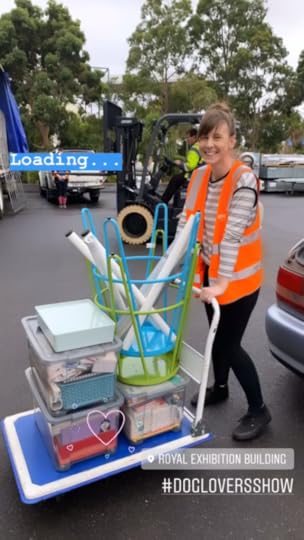
Here is an example of tagging accounts in order to cross-promote. It’s likely that at least some of these accounts included her in their stories as well:
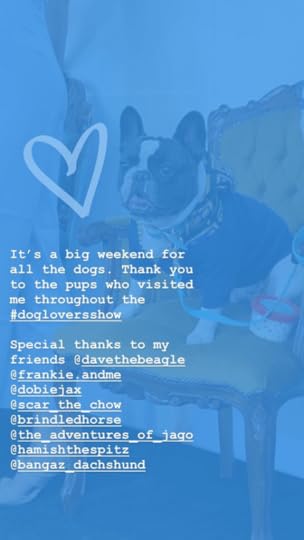
More cross-promotion:
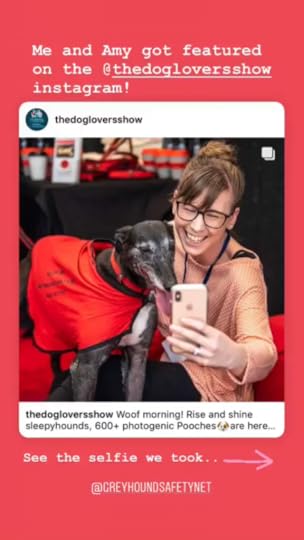
@maggimcdonaldart
Maggi McDonald has her Instagram game down. Check out our podcast interview with her here: Setting Energetic Boundaries & Finding Your Thing with Maggi McDonald. Maggi has experience in retail merchandising, which means that in addition to being a wonderful artist she has an eye for design and branding- a glance at her instagram account makes this clear. Similar to Jessica, Maggi uses her instagram stories for event promotion, cross-promoting with other accounts, and creating intriguing images of her art with the help of gifs and text.
Here Maggi shows us another way to cross-promote, tagging other artists whose work hangs on the wall next to hers in a gallery. Images like this are very likely to be re-posted by the other accounts who are tagged:
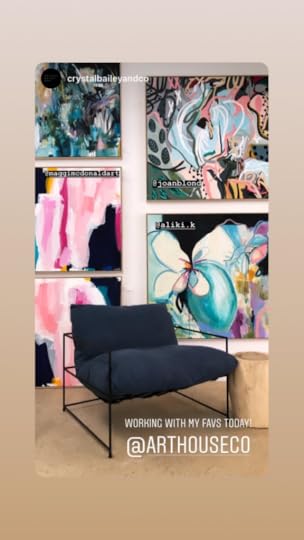
A little bit of storytelling and some strategic gifs make this story more interesting to look at than simply an image of the new piece:
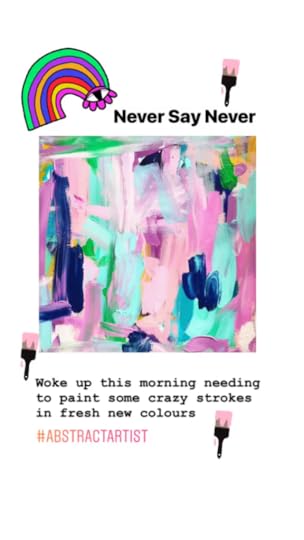
For large accounts that can incorporate links in their stories, a call to action like this is enhanced by the “free shipping” graphic. Tagging the gallery increases the chances of getting reposted:
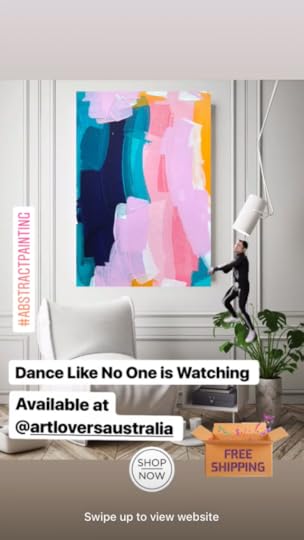
Did you know you can include polls in your stories? Here Maggi uses the poll to include her fans in the process of deciding whether to create more pieces in a certain style. This helps her audience feel invested in and attached to her work:
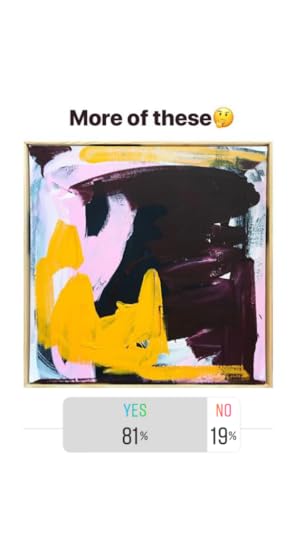
You can also use stories to allow your fans to ask you questions. This is a great way to strengthen your relationship with your audience, and allow them a peek behind the curtain. It’s a really useful tool for artists who teach online art courses:
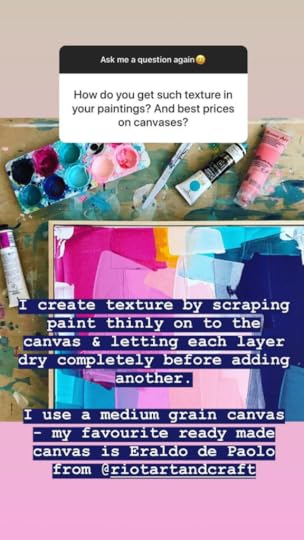
More cross promotion, this time tagging the art supply companies. Another great way to get other accounts to feature you:
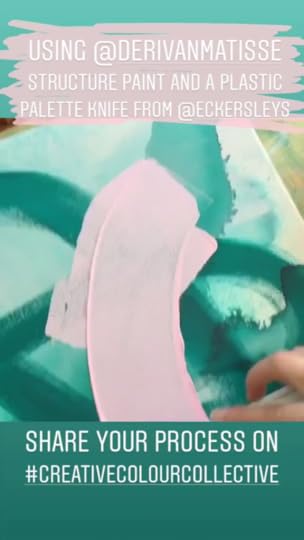
A few takeaways
What can we learn from Jessica & Maggi’s Instagram stories?
Cross-promotion is key. If you hope to get other accounts to feature you, you need to feature other accounts. Create an attractive and shareable post tagging other artists, galleries, events, or products to increase your chances of having others share it and broaden your reach.
Make use of the breadth of features. Plain images and videos are fine, but Instagram is designed for image enhancement, and it’s what your viewers will expect. Make use of the gifs, text, and filters that are available. That doesn’t mean that every image has to be busy and moving, but a well-placed gif can make a memorable statement.
Make your stories interactive. Create a poll, invite your fans to ask questions, invite DM responses, and insert links if you have the capability. Thanks to the wide variety of interactive features available in Instagram stories, brands can forge a really unique and personal relationship with their fans that has them feeling very affectionate and invested in the product. And if something falls flat… don’t worry! It will disappear in 24 hours.
Artists Using Instagram TV
IGTV is the newest Instagram fixture. An account that has IGTV will have a little television icon on their profile page. IGTV is essentially YouTube, but on Instagram. Videos tend to be a little longer than stories, and can be recorded seamlessly. IGTV is actually a standalone app, but the functionality is available within the Instagram app as well. IGTV videos can actually be up to an hour long, rather than being limited to 60 seconds (if you’re uploading a pre-recorded video to Instagram. You can upload nearly as many 15s snippets to your stories as you want.)
Like YouTube, IGTV uses “channels”, but the channel is simply the creator’s account. IGTV differs from stories in that it’s simply a video platform, so you won’t be able to enhance with text, gifs, polls, etc. But if you have an audience built in to Instagram already or are looking to grow your audience with video without branching out to a separate platform, give IGTV a try.
Maggi McDonald uses IGTV for process videos:
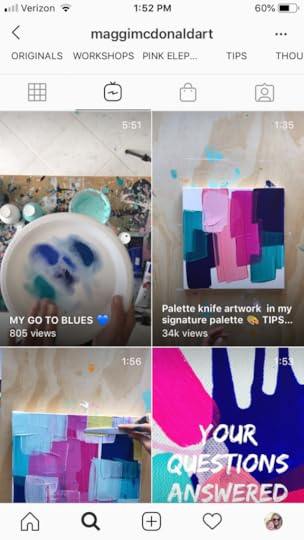
Although it’s a very helpful tool to use if you’re on Instagram and interested in using video to reach your audience, IGTV is not actually under the umbrella of ephemeral marketing because the videos do not disappear- they remain on your channel until you delete them. IGTV is a place for videos that have a bit more planning and polish behind them. Perhaps try some new things out in your stories, and use the Insights feature to help you determine what may be worthy of a longer video on IGTV.
Instagram Story Insights
If your Instagram account is a Business account (it’s still free), you can view Insights for your posts and stories by clicking the menu icon in the upper right corner. With Insights, you can see quantities for Reach, Profile Visits, Impressions, Link Clicks, Replies, Shares, and 10 more metrics. Though not super customizable or in-depth, these insights provide a helpful snapshot of which stories worked and which did not.
You are also able to see who all has viewed your stories simply by clicking the lower right hand corner of your story once it’s live. This provides a really interesting insight: how many people who began watching your story continued watching it until the end?
Are you using Instagram stories (or perhaps Snapchat) for your art business? Let us know in the comments!
The post How Artists Use Instagram for Ephemeral Marketing appeared first on Online Marketing for Artists.
October 28, 2019
How Copyright Works for Fine Art
When you create a piece of art, what exactly is it that you own? What about the techniques you invented to create it? Do you own those? What happens when you sell the original- what rights to the work do you retain? These are just a couple of the burning (and extremely important) questions that artists have about copyright. While we aren’t legal professionals, we’ve worked hard to lay out the basics of copyright law as it pertains to visual artists in a simple way that makes sense. (This post does not claim to be legal advice, nor should it take its place. Please see resources at the end for some links to law professionals who can help you with specific legal situations.)
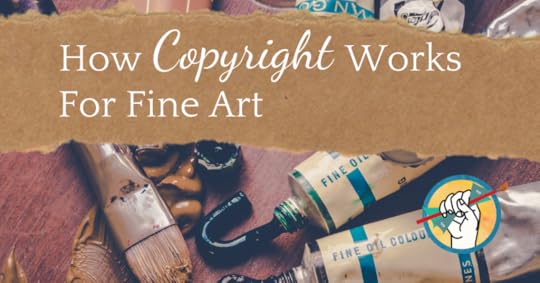
What is copyright?
The word copyright refers to the law that protects the work of individuals, including but not limited to literature, music, film, and visual art. The official umbrella term for protected works is “official works of authorship”, according to Title 17 “in any tangible medium of expression, now known or later developed, from which they can be perceived, reproduced, or otherwise communicated, either directly or with the aid of a machine or device. Works of authorship include the following categories:
(1) literary works;
(2) musical works, including any accompanying words;
(3) dramatic works, including any accompanying music;
(4) pantomimes and choreographic works;
(5) pictorial, graphic, and sculptural works;
(6) motion pictures and other audiovisual works;
(7) sound recordings; and
(8) architectural works.”
For the purposes of this post, we are referring to (5) pictorial, graphic, and sculptural work (i.e. visual art).
Copyright specifically refers to the protection and ownership over the rights to copy, exhibit, and distribute the original work and any copies. The simplest way to explain what is and isn’t protected by Title 17 is to walk through an example scenario:
Imagine you create a watercolor painting of a sheep in a field. You start out with a digital color study in Photoshop. You complete the color study in one hour, and you hit “save”. That color study, though it’s not your finished watercolor painting, is immediately protected under copyright law. If you were to upload the image to an Instagram story to share your art-making process, you would not need to include any verbiage to indicate that it is copyrighted- it is protected simply by virtue of being created by you. (However, it is within your legal rights to place a copyright notice on your work- see the proper way to do it here: https://www.copyright.gov/title17/92chap4.html)
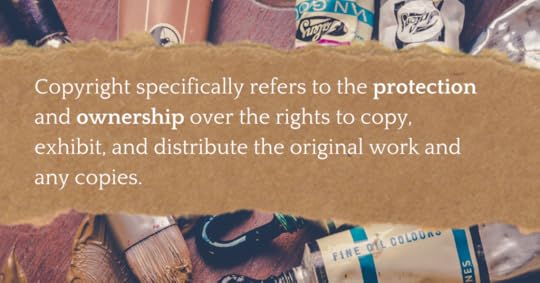
Each subsequent draft you may create is also protected by copyright, as well as the final piece. This copyright protection affords you the following:
Exclusive rights to create and distribute copies of the work both physically and electronically. “Distribution” includes selling, any other transfer of ownership, rental, lease, or lending. Being the copyright owner also gives you the legal right to grant the permission to create and distribute copies to someone else.
Exclusive rights to prepare derivative works based upon the copyrighted work.
Copyright also means you get to claim authorship of your work, and prevent your name from being associated with any work that you did not create, or any modification or distortion of your work that you do not want associated with your name.
Why do artists need to care about copyright?
Copyright is your primary defense in the event your work is stolen, so it’s important to understand exactly how it applies to your art and what it protects against. There can be no accusation of “infringement” without copyright law, so it can be a powerful ally for artists. The very public case of Lisa Congdon is an example of a copyright infringement dispute that gained a lot of traction in the art world. Read more about the case here: https://lillarogers.com/lisa-congdon-my-art-was-stolen-for-profit-and-how-you-can-help/
Without the legal right to make a copy (this includes derivative works outside of fair use), copyright infringement is illegal, though “it does not generally fall under the same criminal provisions as other types of theft, like stealing someone’s physical property” (LegalZoom).
Copyright is important to understand inasmuch as it is important for you to understand any of your rights as an American citizen- ignorance of the protections afforded to you by the law may lead to you allowing yourself to be taken advantage of simply because you don’t know that there is any other option.
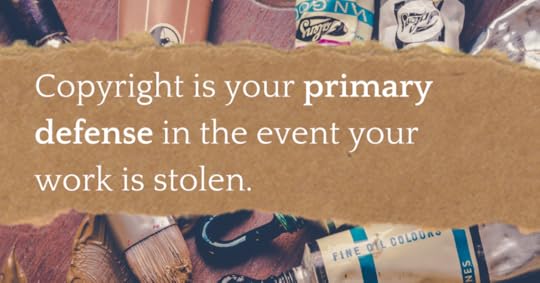
Copyright FAQ
Q: Can I copyright the technique I have developed for my art?
A: No. Even if you believe you are the first artist to ever use this technique, you cannot copyright an art style or technique. You can only copyright the works you create with the technique.
Q: Does selling an original work also sell the copyright?
A: No. Ownership of a copyright and any of the exclusive rights accompanying it is separate from ownership of any material object in which the work is embodied. While it is possible to transfer a copyright, the copyright for any work does not automatically transfer along with the sale of the original work. (Clients who desire some of the exclusive rights of a copyright owner should be expected to pay extra: see our post on Exclusivity in Artist Contracts.)
Q: What qualifies as a derivative work?
A: A derivative work is a work based on an existing copyrighted work. Common examples of derivative works include translations, musical arrangements, and art reproductions. As it relates to visual art, a derivative work would be something like a sculpture based on a drawing, a painting based on a photograph, or a drawing based on a painting. A derivative work is sometimes called an adaptation. Adaptations may only be produced with permission from the original copyright owner. For more information on derivative works, check out this download from the U.S. Copyright Office: Circular 14: Copyright in Derivative Works and Compilations.
How do I register my copyright with the copyright office? (And do I need to?)
First of all, registration is not a condition of copyright protection. Your work is protected as soon as you create it. Registration does, however, carry with it the perk of definitive proof of the date of the copyright and definitive proof that you are the owner of the copyright. This is helpful if you ever need to pursue legal action for copyright infringement. Also of note, the available damages are more significant if you have registered your work with the copyright office. Some artists, authors, and musicians choose to register their copyright before publishing their work.
In order to register your copyright with the U.S. Copyright Office, you must send in a copy of the work (called a deposit) in addition to filling out the application and paying a fee of $35+ (depending on the variables of the work in question). To see the fee breakdown, download this PDF: Copyright Office Fees. Check out this free checklist from Kiffany Stahle: Ready to Register Your Copyright?
What do I do if my copyright is infringed?
It’s every artist’s nightmare. You are perusing a Christmas ornament catalog when suddenly you see a set of ornaments decorated in the exact style of a recent original painting series you created and published online. It can’t be a coincidence… can it? Before you can pursue legal remedy, you need to be certain that your copyright was indeed infringed, and that the case does not fall under fair use.
According to Title 17, the definition of infringement is as follows:
Anyone who violates any of the exclusive rights of the copyright owner as provided by sections 106 through 122 or of the author as provided in section 106A(a), or who imports copies or phonorecords into the United States in violation of section 602, is an infringer of the copyright or right of the author, as the case may be.
Again, the referenced “exclusive rights” as they apply to visual arts are:
(1) to reproduce the copyrighted work in copies
(2) to prepare derivative works based upon the copyrighted work;
(3) to distribute copies of the copyrighted work to the public by sale or other transfer of ownership, or by rental, lease, or lending;
Copyright infringement generally includes reproduction, distribution, display/performance, or the production of a derivative work.
So what do you do?
According to Title 17, all civil and criminal proceedings must be enacted within 3 (for civil cases) or 5 (for criminal cases) years of the original date that the infringement was made. This makes it very important to pay attention to where your art is appearing- there is a statute of limitations on copyright infringement cases.
When you discover what you suspect is copyright infringement, some finesse may be required. Where did the copyrighted work appear? Is it being sold for profit? Is there any chance that the work is merely very similar to yours, but not a copy? Ask yourself these questions once you’ve calmed down enough to see straight, and consider whether you should approach the individual directly or whether you should hire a lawyer. A lawyer may be the better option for dealing with large companies or cases where it’s very clear that the other party is profiting off of a clear copy of your work.
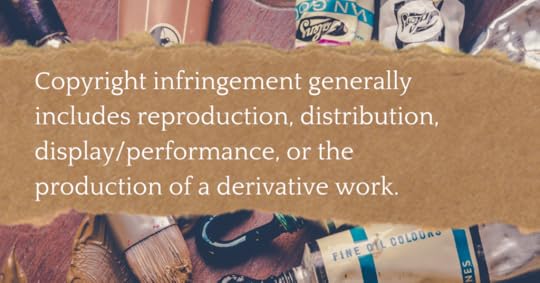
One of our favorite resources for dealing with infringement issues is Kiffanie Stahle of The Artist’s J.D. She has put together a huge list of free and paid legal resources for artists. Check out her free workbook on How to Deal With Copycats. If you are a member of The Abundant Artist Association, you can also access a replay and transcript of our exclusive interview with Kiffanie: Copyright Basics with Kiffanie Stahle.
Fair Use
There are cases when an individual is protected by Fair Use, a doctrine in copyright law that allows for your work to be used without penalty in certain cases including commentary and criticism (including teaching) and parody. For example, under fair use a teacher may take an image of your work and include it in a slide show about the history of watercolor painting, or an art critic may reproduce it in an article critiquing work that you showed publicly. If you feel that your copyright has been infringed upon, a judge will consider four factors:
(1) whether the work was used for commercial or non-profit purposes
(2) the nature of the original copyrighted work
(3) the amount of the work used
(4) any effect the use may have on the market value of the copyrighted work
Final Thoughts
Because copyright law is the artist’s primary line of defense against intellectual theft, it’s imperative that artists understand how it works, what it protects, and what it doesn’t. That being said, there are some artists who have educated themselves on copyright law and have decided to shirk the model in favor of a much more open and interactive way of engaging with their fans, admirers, fellow artists, and customer base. Gwenn Seemel has some unorthodox ideas about copyright that have worked very well for her art business. She disseminates her work freely without restrictions on personal or commercial use. As she says in her post A Business Model for an Artist Who Does Not Use Copyright, “though this business model involves a lot of hard work, it’s a whole lot easier than the other route, the one that embraces copyright. In going that way, an artist is gambling. The driving force in that career path is the fervent hope that one day the artist will make a work that everyone wants a piece of, a work that they can cash in big on with the help of licensing fees and copyright infringement lawsuits.”
Gwenn’s views on copyright and how art is best shared is encouraging even if you disagree with her ideas, because she proves that artists whose desire is not to be boxed in by convention are limited only by the confines of their imagination, and perhaps their willingness to step outside their comfort zone.
Have you had a good or bad experience with US Copyright Law? Do you agree with Gwenn’s point of view, or have you relied on copyright to keep your business afloat? Let us know in the comments!
Further reading
Copyright Law of the United States (Title 17)
Copyright Basics (Artists Rights Society)
A Beginner’s Guide to Copyright Law for Artists (CartoonBrew)
Gwenn Seemel, Art Marketing, Copyright, and More (The Abundant Artist)
How YouTube Sees Copyright (The Abundant Artist)
Copyright Basics with Kiffanie Stahle (The Abundant Artist Association members only)
The post How Copyright Works for Fine Art appeared first on Online Marketing for Artists.
October 21, 2019
Sponsorships for Artists and Other Unusual Business Opportunities
Have you ever considered pursuing sponsorship as a type of support for your art business? Sponsorship is a form of advertising in which a company chooses deliberately to associate with a particular individual who already has an audience. You’re familiar with one of the most well-known forms of sponsorship, though it may be so ubiquitous that you barely notice it: product placement.
But product placement is not the only kind of sponsorship available, and in fact there may be much better options available for business-savvy artists with an active audience. You’re probably not going to cover your smock with business logos a la NASCAR, but you may find that municipal or artist coalition sponsorships are a great match for the kind of work you create.
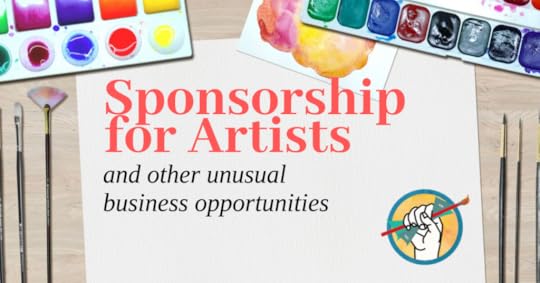
Why should artists bother with sponsorship? Sponsorship may be the best option for artists who work on large or complicated installations or are working in unusual or experimental media. Artists who are working in multiple mediums or creating pieces that cannot be easily sold as originals or prints (think multimedia installations) may also benefit from sponsorship. Isaac Julien’s “moving image” film installation is a good example of work that benefited greatly from corporate sponsorship: https://www.artsy.net/article/artsy-editorial-new-era-of-corporate-art-sponsorship
But what if you’re not creating large multimedia installations intended for museums? Is sponsorship an avenue worth exploring for the average artist just trying to make a decent living? We think the answer is yes. We’ve put together a list of some of the most common types of sponsorship- you may be surprised at the possibilities.
Product placement
“Product placement” might make you think of this or that large cola brand, or it may bring to mind a certain chocolate and peanut butter candy that made a bold choice to be featured in a 1982 science-fiction film featuring a certain lovable extra-terrestrial.
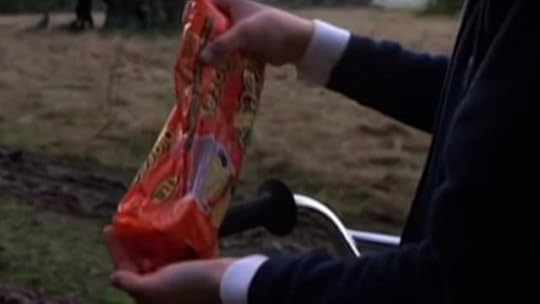
But product placement isn’t just for film. Between YouTube, IGTV, and the rising popularity of live streaming art on platforms like Periscope and Twitch, artists have an opportunity to leverage their popularity before art supply brands to get themselves free products and monetary sponsorship. (See our guide to live streaming.)
The first thing to understand is that corporate sponsorships like product placement are not for newbies. Unless you have already built a business and cultivated an audience and are now ready to branch out into streaming or other video content, you’ll need to spend the time and put in the hours to build your brand before you can approach potential sponsors. Consider the sponsor’s perspective. This aspect of research is not too different from researching influential Instagram partners (see our conversation with Anita Nowinska for more on leveraging influencers)- consider what you have to offer, not just what you can get out of the deal. Who is your audience? What do they like? What products are they likely to want to purchase? If you produce live art streams or tutorial videos aimed at other artists who want to learn from you, then you may be a good candidate for sponsorship from art supply companies.
How do I get a product placement sponsorship?
Before you begin reaching out to potential sponsors, you will want to take a good look at the current state of your business. Visit your website and social profiles as if you were a potential sponsor. Would you like what you see? Here are a few good practices to begin before you ever send an introductory email to a potential sponsor:
Start name dropping
It will be jarring for your audience if you never once mention a brand or company and then one day are suddenly sponsored by one and you mention them in every other post. One way to dip your toes into the world of product sponsorship is by including product reviews or shout outs in your content. Many artists post images of their work along with a caption detailing the brands of all the supplies they use- many fans ask for this information anyway. It’s very easy to produce a slick-looking flatlay image for Instagram with tags for each material pictured. (For more on how to photograph a flatlay, check out our interview with Maggi Mcdonald.) Tagging is also a quick way to get a company’s attention, if they’re on Instagram as well. Honestly and authentically sharing products that you love will let companies know that you can be trusted to talk about their products.
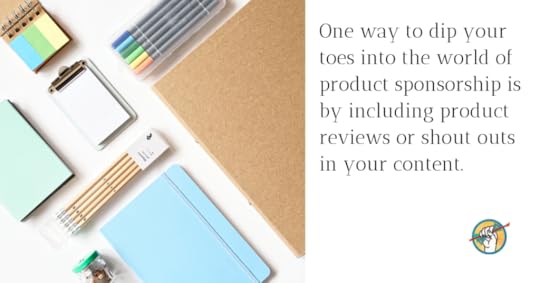
Be professional
A sponsoring company will want to know that the brand they are associating with is consistent and professional. Many larger companies actually use marketing agencies to vet potential artists (of all kinds). Those professional vetters will be looking for telltale signs that you may not be a good fit for certain brands: profanity, racist/sexist jokes, NSFW content (this likely wouldn’t include figure drawing), unprofessional interactions with fans, or inconsistency in schedule or content will all be likely to exclude you from a lot of potential sponsors. Before you begin your search for sponsorship in earnest, clean up your feeds.
Pay attention to your branding
Your brand may just be yourself, and that’s fine, especially for artists. The key is to be deliberate and consistent about your branding. Take a look at your social profiles, video channels and streams, and especially your website to make sure that your branding is consistent across all platforms. What’s your messaging? How to Sell Your Art Online 101 will be a really helpful refresher for identifying your audience (which should overlap significantly with your potential sponsor’s audience) as well as your own story and the voice in which you tell it.
How do I find companies to sponsor me?
There are a few websites out there that purport to connect artists with potential sponsors. You may want to check out Indiesponsor, which for $9 a month will provide you with a profile page and access to a list of sponsor opportunities.
You may want to start simply by making a list of the products you wouldn’t mind shilling for. Are you a major Wacom fan, or do you live and breathe Adobe? Do you casually evangelize for Prismacolor or Dr. Ph. Martin? Make a list of the brands you use and love. From there, do some searching for similar brands, because it’s not terribly likely to strike gold with the first big company you think of. But smaller companies who don’t have the budget for big timers may be much more willing to partner with you.
Try researching products that would be a good fit for your brand with ProductHunt, a website that lists the latest newly launched products across the internet. Companies launching new products will be especially interested in building momentum and garnering interest through strategic product placement sponsorships.
Making the Ask
Once you’ve done the research and prepared your business, how do you convince companies to sponsor you? Most importantly, you need a clear understanding of how the potential sponsor will be benefiting from the partnership. Will your work bring new attention or new business to the company? Is your art associated with a charitable cause that will make the company look really good for sponsoring you? Write down clearly how the sponsor will benefit from association with you and your work.
What does making the ask look like? Picture a business on a busy street. The business has a blank wall that faces traffic. An artist writes a proposal that lays out clearly for the company how a bright and eye-catching mural will attract attention to their business. It includes a clear budget, and asks the company to sponsor the mural. The company gets attention, the artist gets work… everybody’s happy!
What if you’re not a muralist? The basic method is still the same: present to the company a proposal that includes your vision for the finished piece, and lays out clearly how the sponsoring company will benefit. Will you hold an event when the piece or installation is finished? How many people will show up? How many people do you expect to see the piece (and to see the sponsoring company’s involvement?) These details will assist the company in deciding whether the project is worth paying for. The more enticing you can make your project look for the sponsoring company, the better your chances of success.
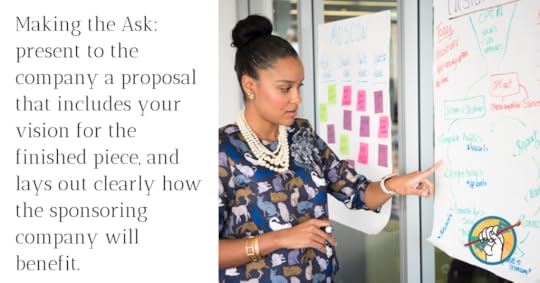
Meet David Choe
We used a mural as an example of a sponsorship partnership between an artist and a company. A case from Silicon Valley, the hotbed of creativity and out-of-the-box thinking itself, has proven that a little creative thinking can produce endless possibilities for alternative ways for artists to collaborate with businesses and organizations.
Perhaps you’ve heard of David Choe- the graffiti artist who agreed to be paid in stock by a small Silicon Valley startup back in 2005, in exchange for painting the entire building. He had initially asked for $60,000 for the project, but after seeing PayPal cofounder Peter Thiel invest in the company, and with a bit of a taste for risk-taking, he agreed to the unorthodox payment method. The company was Facebook, and Choe is now worth $200 million.
Naturally, this is not going to be the fairy tale ending for every artist who enters into an unusual sponsorship agreement, but it’s proof that artists who aren’t afraid to take risks and think outside the box may be rewarded for their optimism.
Municipal sponsorship
Municipal sponsorship will vary from city to city depending on your town’s individual art programs and budgetary priorities. Municipal sponsorship can take a variety of forms, from monetary contribution to arts festivals to hiring artists to create murals and sculptures. There is publicly funded sponsorship out there for artists- it may just be a matter of finding it. “According to Americans for the Arts, in 2015, 35% of local arts agencies (LAAs) provided financial support to individual artists, and 30% supported both arts organizations and artists.” (Grantspace)
How do I Get Municipal Sponsorship?
Get plugged in
The best way to find these kinds of sponsorships is to get familiar with your local government. Make friends with individuals inside city hall, scour the city government website, and join your local artist’s guild to connect with other local artists, some of whom are likely to know their way around your local municipal sponsorship structure.
Explore what’s available
One simple example of a municipal sponsorship is a mural grant, which is a relatively ubiquitous form of public arts sponsorship which allows a single artist, artists group, business, or nonprofit to put together a public mural along established guidelines, often with monetary assistance attached. Try Googling “Your city + mural + application” to get an idea of what may be available in your city. Here’s an example from the city of Milwaukie near Portland, Oregon: https://www.milwaukieoregon.gov/arts-committee/public-art-mural-guidelines-mural-application
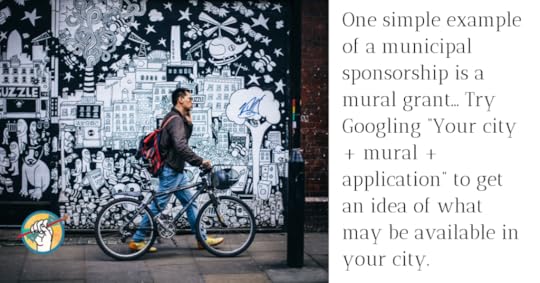
Evaluate your work
If you’re interested in pursuing municipal sponsorship, your first step should be evaluating your artwork and your messaging. How can you provide value to your town with your art? It may not be a mural or any kind of art in a public space- it may be a series on local landmarks, town founders, or a relevant political issue that impacts your city. Getting involved with your town’s local arts organizations, planning committees, etcetera is one of the best ways to get your finger on your town’s pulse and determine how you can best partner with it to produce art that your local municipality would be excited to sponsor.
Artist coalitions and nonprofits
Artist coalitions and charities are organizations that exist to support and fund artists. These may be less restrictive in what they allow than municipal bodies. On the other hand, they may be extraordinarily specific in the kind of art they support, which can be an advantage depending on the kind of art you create.
Determining which arts-focused nonprofits are a good fit for your work is going to require research. Try greatnonprofits.org, which currently provides a 50-page list of arts and culture nonprofits complete with extensive reviews and contact information. (Be aware that not all of the nonprofits listed there provide money to artists- some solicit free art from artists for placement in locations like hospitals.)
Artist coalitions most often support public cultural projects and events, and often require artists to submit an official grant proposal. Try searching for “Your city + artist coalition” to see what’s available. For some really helpful information on how to write grant proposals, check out our post How to Write Grants for Your Art Project.
Patronage
Patronage most often brings to mind wealthy benefactors commissioning gilded-frame oil portraits in centuries long since passed, but patronage as a model is alive and well today, although it’s shifted somewhat and taken on new life on the internet. Patreon is one such example, a blend of crowdfunding and traditional patronage that allows fans to support an artist’s work on a monthly basis in exchange for closer access to the artist, sneak peeks behind the scenes, and first/exclusive access to commissions and extra artwork.

A brief history of artist patronage
Art patronage is as old as the imperialist and feudalist societies in which it has most often been found throughout history. The distinct origins of the patronage model are unknown, although it most often was heavily tangled in politics. In fact, in many societies patronage was the key to social mobility and status. Michelangelo’s most famous patron was Pope Julius II, which had just as much to do with the famed artist’s rise to prominence as did his remarkable talent.
Modern artist patronage seemed to have disappeared for a time, receding to a type of organizational support such as underwriting a ballet or a museum exhibit, but according to a NYT article on patronage: “Funding based on a collection model is backward,” said RoseLee Goldberg, an art historian at New York University and the founder of the performance art nonprofit Performa. “There isn’t this support for an artist if they don’t have big object to sell.” Ms. Goldberg believes today’s patrons are similar to the “angel investors” of tech. “You see that something has potential to grow and you want to support that incubation period,” she said.”
Where to find contemporary arts patronage
Contemporary artists may continue to see an uptick in more traditional patronage through incubator programs like In4Art, which matches patrons with artists and underwrites materials and “creative development”, that aforementioned incubation period.
Patreon, as mentioned before, is also a valid model of patronage, with a modern twist. Financial Times describes it this way in an article on modern patronage: “The model is less like the Victorian system of arts patronage, in which benefactors subscribed to put up a statue, and more like the aristocrats who clubbed together to give Beethoven a life-long stipend “to make my life trouble-free”, as the composer wrote.”
Like every kind of sponsorship, finding a patron often begins with the simple but powerful act of networking. Try volunteering for museums and other arts organizations that connect regularly with arts patrons.
Regardless of the sponsorship method, the artist that is going to find the most success at securing sponsorship will be the one who has paid close attention to how they represent their brand, tell their story, and stand out in the market. If you need some help solidifying what your art’s message is and how to share it with interested potential sponsors, check out How to Sell Your Art Online 101: The Story of Your Art
The post Sponsorships for Artists and Other Unusual Business Opportunities appeared first on Online Marketing for Artists.
October 9, 2019
Constant Contact Introduces New Website Builder: Should Artists Give it a Try?
In February of 2018, we surveyed over 1,000 artists to ask them what their favorite website builders are (check out the full post: The Ultimate Guide to Choosing an Artist Website Builder). In our evaluation, Squarespace came ahead as the most popular website builder due in large part to its intuitive drag and drop functionality, and the ease with which you can quickly create a visually appealing site.

Since that time Constant Contact, a popular email marketing platform, has unveiled their new free website builder. We sat down and worked through the process of creating a free website with the Constant Contact builder to help you determine whether it may be a good option for creating your artist website. We created a free website, but it should be noted that starting at $10/month you are given the option to connect your domain, increase the number of products in your store (the free version allows only 3), and access increased support.
First Impressions of the Constant Contact Website Builder
The builder initially functions like a Setup Wizard you may run through to install software on your website, asking you questions about the category and name of your website. Being forced to choose from a pre-determined set of categories may be irksome for those among us who typically resist being labeled or categorized. That being said, there are a lot of options to choose from.
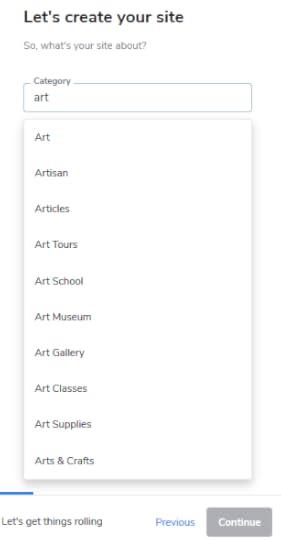
At this point the wizard asks you to choose a stock image or upload your own. We would recommend a quick breeze through the setup wizard, because later on you’ll have the chance to make more detailed changes to all the features of your website. There really isn’t a need to spend too much time deliberating over details at this stage. However, similar to the category limitations, there is a very limited number of color palettes to choose from. Artists may find the limitations frustrating.
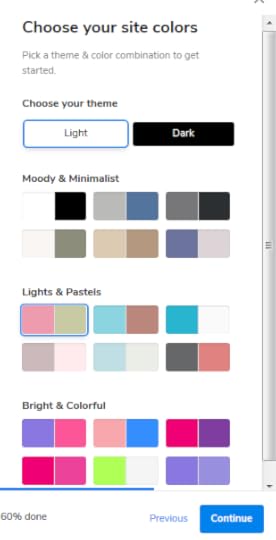
Once you’ve run through a few more details including contact info and a font style (once again, limited choices), you will create an account to save your work and choose whether to continue with the free version, or upgrade.
Should I Upgrade?
The most important reason to upgrade your Constant Contact website is going to be the domain. For just $10 a month Constant Contact allows you to either connect your existing domain, or choose a unique domain. Without the upgrade, your website domain will read yourname.constantcontact.com. While it’s fine for hobbyists and beginners finding their footing in the world of online art, ultimately it’s unprofessional and difficult to be taken seriously without a proper domain.
The Design Experience
There is another significant reason to upgrade, which we’ll get to in a minute. But how is the overall experience of creating a website with Constant Contact? We were pleasantly surprised by the wide array of options available to really customize your site. The pre-built page templates take hours off of the time it will require to get your site up and running. And depending on what kind of sections and pages you need on your site, you can choose from pre-built templates for:
Contact Form
FAQ
Blog
Address
Business Hours
Call to Action
Countdown
Cover Image
Event
Gallery
Media
Paypal
Store
… and more. Each of these templates allows for design edits such that there aren’t too many limitations to how you can use your site.
The editing functionality is extremely easy to use, even for artists who cringe at the idea of creating their own website. Each section or page has multiple layout options, and turning features on and off is done with a simple button toggle. Constant Contact clearly intended for their website builder to be accessible even by those completely new to website design.
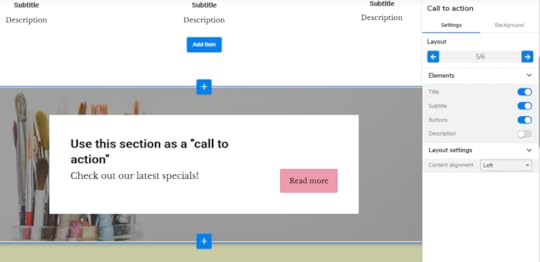
Setting up a beautiful gallery is incredibly easy. Unlike the store feature, you can choose from portrait, landscape, or square for your aspect ratio, and include as many or as few images as you want.
The Store Feature
The store dashboard is easy and intuitive to use. Within the dashboard you have the ability to set the product style, details, price, and shipping type (free, flat rate, or per-product). The image uploader crops all listing images to a landscape ratio.
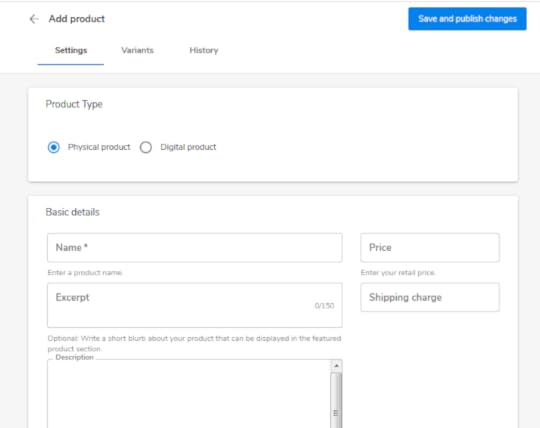
Constant Contact pushes Paypal as its primary payment portal, although it also offers Stripe. Unless you upgrade to the Business Plus plan for $20/month, Constant Contact takes a 3% transaction fee per sale on top of any applicable payment processing fees incurred from Paypal or Stripe.
Overall the store is fun and easy to set up, but the free version comes with a massive limitation: only three products are allowed. Attempting to add a fourth product will redirect you to the upgrade page.
$10/month will provide you with seven more product slots. This still feels extraordinarily limiting for an artist trying to sell their work on their website. It may work out if you are an artist that primarily works on commission and only need a couple of product slots for the different commissions you offer, similar to the way many artists sell commissions on Etsy. Otherwise, be prepared to shell out $20/month for the Business Plus upgrade, which not only removes the Constant Contact transaction fee, but also allows unlimited products in your online store.
Should I Build My Website With Constant Contact?
If you already use Constant Contact for managing a mailing list and want to keep all your stuff in one place, by all means create your website with Constant Contact! Although the store limitations and extra transaction fee are annoying, they aren’t unfair or out of the ordinary. The available analytics seem to be pretty robust, even at the free level. We do recommend that if you are serious about using your website to sell your art, you upgrade to at least the basic Starter plan in order to have a proper domain.
The website builder is simple and intuitive enough to make designing your website easy and fun, and the upgrade prices are right in the middle of two of the other most popular artist website builders: Constant Contact is about $25 more expensive than FASO, and about $25 cheaper than SquareSpace. So it may hit the sweet spot for some artists, especially if they already use Constant Contact. Constant Contact is much more user-friendly and less time-consuming than the more advanced website builder options like WordPress and Shopify. If you want to take a crack at building your own site but don’t enjoy the challenge of getting into the HTML/CSS or dealing with plugins and other advanced integrations, you may want to give Constant Contact a try.
Have you built a website with Constant Contact? How did it go? Love it or hate it? Let us know in the comments!
The post Constant Contact Introduces New Website Builder: Should Artists Give it a Try? appeared first on Online Marketing for Artists.
September 24, 2019
Start Finishing by Charlie Gilkey Review
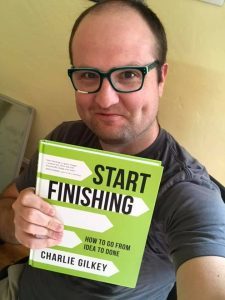 It’s hard to write about the work your closest friends do. Charlie Gilkey, founder of Productive Flourishing, is literally a warrior-philosopher, and one of the very best people I know. I don’t know how to express how proud of him I am for this book.
It’s hard to write about the work your closest friends do. Charlie Gilkey, founder of Productive Flourishing, is literally a warrior-philosopher, and one of the very best people I know. I don’t know how to express how proud of him I am for this book.
Charlie Gilkey has been a secret weapon for dozens of entrepreneurs and thought leaders you definitely know. His work has been influential for years, and I’m excited to see his second book hit the shelves and get the advance praise it really deserves.
We’ve had Charlie on a guest teacher for a masterclass for The Abundant Artist Association. Members of the Association can access that training from the members page here.
I had the pleasure of getting an advance copy of Start Finishing* and found that Charlie’s book is exactly what so many creative people need. I’m a performer, writer, serial entrepreneur and marketer, and find that many of my fellow artists and creatives struggle with the organizational structure it takes to finish projects.
Whether its simple concepts like time-blocking, building a success pack, or mindset shifts that show you can change your productivity by having compassion for your own creative quirks, Charlie shows that he has deep experience working with creative people of all stripes.
Start Finishing is a game-changer for Creative People. The productivity genre is filled with hacks, tricks, and half-baked strategies that oversimplify productivity or turn productivity into an overly-complex organizational challenge that most people don’t have the patience to learn. Start Finishing reflects a paradigm shift in thinking about productivity that is grounded in both real-world application and solid academic theory.
If you struggle with finishing things, read this book and implement what you can. Then read it again and implement a little more. It’s not scary, and it is full of useful insights from some of the top minds in the business world who share their insights into working within Charlie’s Framework.
The book is available pretty much everywhere books are sold. Here’s a link to the book on Amazon*.
The post Start Finishing by Charlie Gilkey Review appeared first on Online Marketing for Artists.
September 11, 2019
The Ultimate Beginner’s Guide to Art Licensing
At The Abundant Artist, we are passionate about teaching artists that it is entirely possible to make money from your art, even outside of the traditional gallery system. In fact, many of our artists make a living from their work without ever setting foot in a gallery. A seldom-discussed aspect of the art industry, and somewhat mysterious to many artists, is art licensing. While it’s not for everyone, it is a facet of the industry well worth exploring for artists who are well experienced with managing their budget and are interested in collaborating with corporations.
Several years ago, Cory interviewed an artist who licenses her art with a wide variety of companies and who founded ArtLicensingInfo.com. Tara Reed is a licensing expert with years of experience, so we use transcribed portions from our interview with her throughout this article, lightly edited for readability.
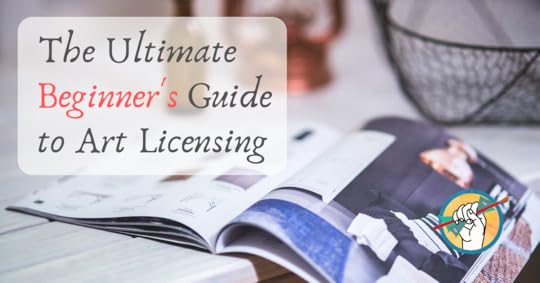
What is art licensing?
Art licensing is a way of making money wherein, as licensing expert Tara Reed puts it, you “rent” your artwork to companies to put on their products. An artist who chooses to license their art may not sell any originals at all, but simply license the images for use on commercial products. There is tremendous potential in the world of art licensing, but it requires a different way of approaching business than more traditional avenues of selling art such as selling originals and prints through galleries or directly to collectors.
Are you willing to collaborate with a third party on every piece of art you license?
Tara Reed gives us a rundown on the basic steps involved in an art licensing transaction:
“In our perfect world… I was just working on this collection this morning of art, and I’ll finish it probably tomorrow and I’ll start sending it out to a couple of clients that I work with all the time. One or two of them might be like “Oh yeah, we like it. Send us the files, we’ll knock something up and see what happens.”
So I’ve done the art, they’re now going to consider it. A lot of what goes on in the industry now, it’s a little different than ten years ago, is they shop your art. So they might show it to some of their key accounts, they might show it to a big account like Bed Bath and Beyond or whatever. They often won’t commit to you until they know they’re going to have decent placement. A little different than in years past. So they have to mock stuff up, they have to show it to people. Then, okay, it’s beautiful, somebody wants it. Then you’re going to do the contract. If I’ve never worked with them before, we have to start from scratch. If it’s a company I’ve worked from we have a basic contract, we’ll do an amendment where we add “Okay, yeah, now you’re licensing this art in addition to what you’ve already done in the past.” So you always have to do the contract thing. Then they have to produce it, they have to sell it if it’s going into mom-and-pop stuff, or they have to ship it, whatever. It can take, I think nine months is the shortest amount of time between when I finish something and when it has shipped. And you don’t get paid until the quarter after it ships.”
How does art licensing work?
Companies that sell housewares, clothing, decor, kitchenwares, etc to retailers need beautiful art to put on their merchandise. Where do they source that art? While some companies have in-house designers and artists, many source their art from freelance artists. What many artists don’t realize about the art licensing process is that it is not normally a simple procession from finished artwork to expensive licensing deal.
So this is the first question to ask yourself if you are interested in licensing your art: are you willing to collaborate with a third party on every piece of art you license? Tara Reed describes a typical instance of receiving feedback from a client:
“Perfect case in point… chalkboard is really popular right now. If you’re on Pinterest at all, you see chalkboard stuff everywhere. So I’ve been playing a little bit with the chalkboard trend with art that I like. So I did this one thing, and I sent it send it to one of my clients who does wall art. And I’m like, “Okay. I think this might be cool. It’s kind of a combination of a chalkboard, and folksy.” And she writes me back, “It’s a cool idea. But it’s too dark. I want a white background, I want brighter yellow, I want a lime green.” Basically, okay, you like the image but nothing else about it. It is so rare to show somebody something and have them say “Perfect, send it over.” There’s almost always a change. 90 to 95 percent of the time there’s a change. In this particular case I pretty much said “Okay, you like the theme. But you don’t like how I did it. But I’m gonna finish doing it this way, see how it goes, and then I’ll let you know when I do a lighter, brighter version of the theme.”
There are some artists who bristle at the thought of receiving creative feedback from a corporate entity, even an art director, who has been removed from the process of creating the piece and may not identify with (or even particularly care about) the heart or message behind it. Other artists, such as professional illustrators, will read about Tara’s experience and say “Yep, that sounds about right.”
It is so rare to show somebody something and have them say “Perfect, send it over.” There’s almost always a change.
Here is how Art Licensing Info puts it in a section titled The Basics of Art Licensing:
“For those individuals who are willing to work hard to create the necessary collections of art needed by manufacturers, to work with the legalities of a contract, who are willing to continually market themselves and their works, and willing to work under a system that does not guarantee immediate income for the work being done, art licensing may be the route to take.”
So what are those “necessary collections of art”?
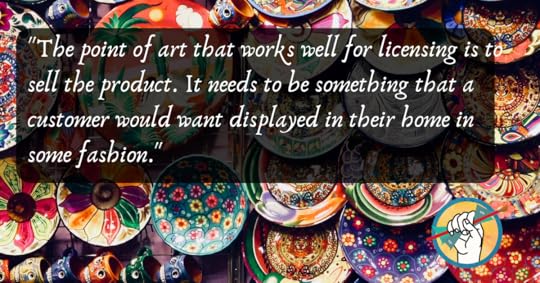
How do you create art manufacturers will want to license?
Art that sells well on manufactured items is art that both manufacturers and customers can relate to, according to Tara Reed. The point of art that works well for licensing is to sell the product. It needs to be something that a customer would want displayed in their home in some fashion. Take a look around your own home and notice what products you’ve purchased with artwork on them without really thinking about it: kitchen towels, tablecloths, cookie jars, clocks and wall art, placemats, etc. The art on licensed products may vary wildly from home to home, but it will have some factors in common such as being a coherent series as well as attractive and appealing to the eye.
For this purpose, there are likely to be some perfectly valid art series that are not a good fit for licensing: overly political pieces, multimedia or 3-dimensional art, sculpture, etc.
If you’ve gotten this far and have decided that you’re interested in collaborating with corporate clients and you have series of art that may be a good fit for licensing, the next step is to figure out how to get started. First, check out Tara Reed’s article The Art of Creating Art Licensing Collections.
How do you get started licensing your art?
This is one of the most common questions from artists who are overwhelmed by the prospect of art licensing. How does one even begin to dip their toe into the vast and seemingly complicated world of art licensing? Once again Tara Reed has come to the rescue, with a really helpful research tactic she uses in order to find manufacturers who may want to license her work:
“It’s called shopping research, and it doesn’t cost you anything. You go to the store, and you find something. You’re like “Oh, that’s really pretty.” A lot of products have the manufacturer on the bottom. So you take a picture of it or you write it down, and then you go back to the internet and you look up that company, and you try and figure out if they license art. And so that’s how I have found some of my clients.
Some you’ll go to their website and it’ll say “Artist Submissions.” So that’s awesome, because they tell you how they want to talk to you to begin with. Others, they might just show artists that, once you learn more about the industry you get a feel for who’s in it. So if Paul Brent’s art is on their product, they license art. Because he doesn’t sell art, he only licenses art.”
So shopping research is also wonderful.”
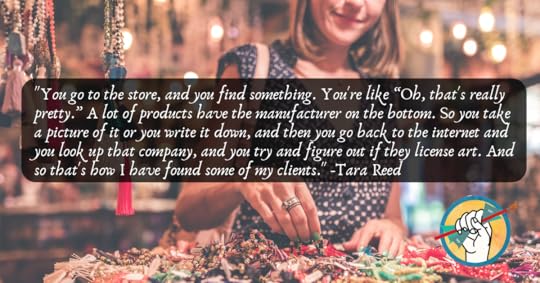
Another option is to attend a trade show. Among the most well-known shows is Surtex, an annual trade show for the surface design industry. According to the Surtex website, Surtex “is the global sourcing destination for companies seeking unique art, designs, patterns and prints for commercial use on home textiles, paper products, bed & bath, lifestyle giftware, décor, apparel, beauty, juvenile, trend services and more.” Surtex is attended by manufacturers, retailers, marketers and brand licensing companies. So whether an artist interested in growing their licensing clientele chose to exhibit or simply attend, the networking possibilities for shows like Surtex are enormous and extremely helpful to growing a fledgling “surface design” business. Surtex claims that they are open to any artist with designs or patterns that can be used on finished merchandise, including photographers, textile designers, illustrators, art agents.
The caveat to a show like Surtex is that it’s in New York City. So unless you’re local, you are looking at a significant traveling expense. As your licensing business grows you may find that it’s worth it to work networking opportunities like this into your budget. But what if you can’t afford Surtex? Look into other surface design trade shows. A small list includes:
BluePrint (San Francisco 2020)
Progressive Greetings LIVE (UK)- this is exclusive to greeting cards
Licensing Expo (Las Vegas)
Tara Reed describes the choice to show at expos (or not):
“75 to 80 percent of my business I can track back to either exhibiting at or going to an industry trade show. So it’s not an inexpensive thing, but I go to New York every May. I set up my ten foot ten booth, and that’s where I meet a lot of the people that I work with.
Some people don’t choose to do that, they’re not comfortable doing that. They don’t have the budget to do that. So there’s other ways to go as well, there are a lot of agents in the industry. So if people just really don’t want to do the business side, like they’re super shy and you’re super intimidated by it, or they just truly want to be in their pajamas painting all the time and not deal with all the others.
Well, find an agent. And then it’s their job to make those connections for you, between your art and the manufacturers.”
What does a fair art licensing contract look like?
Contracts vary wildly from company to company, and depending on the type of licensing deal. The appeal of art licensing is that you can actually license the same piece of art for usage by multiple companies on different products, maximizing your earning potential. As Tara describes it, “Here’s the beautiful part. Because you slice and dice it through a contract, I’m still free to take the same Santa Clause that you’re gonna put on wrapping paper and license it to somebody else to put on tissues, and to somebody else to put on paper plates, and to somebody else to put on ceramic plates, and to somebody else to put on wall art, and somebody else to put on stickers. It’s endless.”
A fair contract will provide you with an industry-standard royalty rate. For in-depth information on standard royalty rates, check out the post Royalty Rates- What is the Standard?
Tara recommends working to negotiate the highest possible rate for yourself. (The Abundant Artist Association members have exclusive access to a talk on negotiation tactics for artists in the call archive.)
The appeal of art licensing is that you can actually license the same piece of art for usage by multiple companies on different products, maximizing your earning potential.
But how do you make sure that the contract offered to you is completely on the up-and-up and isn’t going to take advantage of you? Do you absolutely have to hire a lawyer? Here’s what Tara has to say:
“Contracts are part of this business. And you do need to understand them. The beautiful thing is you don’t always have to have an attorney. Another artist and I wrote an e-book called How to Understand Art Licensing Contracts. And so it goes through all of the pieces, like this is what you want in every single contract.”
The important thing to note is that while hiring a lawyer can be really advantageous for clarifying the legalese in large contracts for large accounts, hiring a lawyer may also cost you more than you ever make from the deal.
“Depending on how you’re building your business, how big of a deal it is, some things might or might not be important. I have worked off of contracts that are one page long to twelve pages long… You can’t cry “I’m an artist, I can’t understand it!” Because it’s really important to your business to at least understand it, even if you don’t take control over the whole thing.
When I first started, I had a friend who used to do contract negotiation, and she helped me learn. You basically have to learn to put on this hat that is the doom-and-gloom worst case scenario hat, and you read each paragraph, and you go “Okay, worst case scenario.” So say my art is on a mug. In my contract I indemnify this manufacturer against the art, so if anybody sues me and says I stole this art, they can’t sue them. But they have to indemnify me against any issue with this mug.”
Tara’s last comment is an issue that many artists are unlikely to consider when entering the world of art licensing: should a customer experience a problem with the product, who is at fault? The artist or the manufacturer? Make sure that these details are clarified in your contract.
For more basic contract help, check out Resources for Writing a Solid Artist Contract .
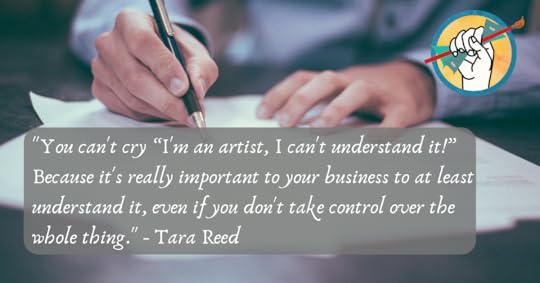
Is art licensing a lucrative business? How much can I expect to get paid for licensing my art?
The answer to this question is a very bold it depends. A helpful resource to have in your library whether or not you pursue licensing is the Graphic Design Artists Guild Handbook: Pricing & Ethical Guidelines. Because of the nature of licensing, there is the potential for it to be extremely lucrative for a savvy and hard working artist who is not afraid to network. However, Tara warns us that artists should not get into licensing with the expectation of a steady income stream to pay next month’s bills:
“You can make five dollars to millions of dollars a year. That’s a really hard question to answer. I mean Mary Engelbreit, Thomas Kinkade, Susan Winget, they’re all making very very big numbers, because they’re very well-known brands, are very established. They have a big consumer base. There are other people who are licensing their art that are making really good money as well, like six figures. And you may never know what their name is, because they may be licensing their designs to Target, and it just has a target label on it. So sometimes you license your art and you don’t get that recognition. Your signature isn’t on it, you’re doing private label.
Some private label will have your name and your brand, and some, well it depends on what you agree to. There’s people that are doing it very part-time, maybe they’re making a couple hundred, a couple thousand. I would say the artists that are making a living like me, that have been in the business, my best guess… because we all don’t sit around and compare our paychecks, and it can really vary from year to year. I mean, I think you’re doing well if you’re making $40- to $100,000, you can make a living at this. It isn’t super easy money. It isn’t like, “Oh, I’m gonna make five things, license it in the next ten years, I’m all set.” It’s not that at all.”
Also important for artists to note is the fact that the pay period for art licensing is normally quarterly. That means four paychecks a year, which is why artists who are serious about pursuing licensing need to be very proficient at managing their money. Tara calls it the cash flow cycle of licensing, and it requires a solid handle of managing your cash flow for your business. Learn more about the cash flow cycle and much, much more on Tara’s free Interview Replays page: http://www.artlicensinginfo.com/interview-replays/
Companies & Agents:
These are by no means exhaustive lists. Take Tara’s advice and do some shopping therapy research of your own! Also see this blog post from artist Joan Beiriger for a very specific breakdown by product type.
A few companies that license art:
All of these companies license art onto their own products, then sell those products in larger retail chains nationwide.
Demdaco: Gifts, fashion, and decor
Andrews McMeel: calendars, paper gifts, etc
Art licensing agents:
Copyright & Protecting Your Work
An essential question to answer when considering selling the right to put your images on merchandise is: how can you protect your work from theft? The first thing to know is that if you create an original piece of art, you automatically own the copyright to that work without filing any paperwork, and you may pursue legal recourse for copyright infringement. However, if you hope to sue the offending party for any kind of punitive award, you will need to take your copyright a step further by registering it with the US Copyright Office.
Among the very best ways to protect your work is to be well-known. Consider an all-too-common scenario: you’ve been licensing your work for a while as well as selling prints and originals from your own website. A collector of yours mentions that they didn’t know you were selling your work so cheap now. “What in the world are you talking about?” you ask, and they direct you to a slick looking boutique website selling cheap apparel… and there’s your art, unlicensed. Stolen.
A case of copyright infringement (and being alerted by a third party) went viral several years ago and rocked the art world was that of Lisa Congdon vs. art wholesaler Cody Foster & Co. Enough has been written on the case already, but to make a long story short, Lisa was alerted by a friend to the fact that Cody Foster & Co was selling ornaments with a design very similar to pieces that she had produced a few years before. Congdon filed a lawsuit against Cody Foster & Co, and the art world exploded with op-eds. Most sided with Congdon. Many high-profile companies ended their partnerships with Cody Foster & Co as a result.
Why would it make a difference whether you’re well known or not when it comes to protecting your art from theft? Every pair of eyes perusing the internet that belongs to someone who would recognize your work if they saw it is a valuable ally. This is exactly how Lisa Congdon was alerted to copyright infringement of her art, and this happens much more often than you would think. In fact a search on Twitter for “my art was stolen” reveals that art theft happens daily, to all kinds of artists, at every skill level and across every genre, style, and medium. The more people who know your art, the more people who can let you know if they see it somewhere it shouldn’t be.
The solutions to protecting any work you post publicly online usually entail diminishing the quality of the image including posting only cropped sections, low-resolution or small images, and using large watermarks. Understandably, this is troubling for many artists who sell primarily through the internet and rely on collectors being able to see their work clearly online. This is why having a large network of fans, collectors, and fellow artists who recognize your art and have your back is so important.
For regular discussions about copyright and protecting your work, Lisa Congdon and Kelly Rae Roberts are helpful artists to follow on social media. (Also be sure to check out our interview with Kelly Rae Roberts!)
Final thoughts
Art licensing is not for everyone. In addition to being willing to create art along popular trends, fashions, and color schemes that are most likely to sell merchandise, you have to be willing to work with third parties, taking feedback and making changes that you may not feel are necessary. Additionally, while licensing can be lucrative, it isn’t going to be the solution for any cash flow problems your business is experiencing. That being said, art licensing can be a great fit for some artists. If you have other streams of income and can manage your money well and the idea of working with businesses to create art that will sell merchandise doesn’t make you break out in hives, art licensing is well worth looking into. You don’t even have to make it your full-time gig: as Tara Reed mentioned, many artists license their art only part time as a supplemental income.
In the Information Age it is easier than ever to begin learning something new. Throughout this article we have shared multiple resources, both here on The Abundant Artist and on the site Tara founded, that will help you get started. Why not give art licensing a try? Let us know how it goes!
The post The Ultimate Beginner’s Guide to Art Licensing appeared first on Online Marketing for Artists.
August 28, 2019
The Ultimate Beginner’s Guide to Live Streaming Your Art
The artist sets up two webcams: one pointed at her face, one pointed down at her desk where she has prepared a piece of cold-press watercolor paper taped to the table, an attractive ceramic pot with water for cleaning her brush, and a tray of watercolor paint. She turns on a lamp on the corner of the desk, another lamp in the corner of the room, and a small lamp clipped to the back of her laptop. She trains this one directly onto the table, the other two lights are pointed at varying angles. She adjusts the position of the lights until the shadows on the desk gradually disappear. She checks her reflection in the webcam, and then hits the button on the screen. She’s live! She begins to paint over the light pencil outline on the paper, and next to a small eye in the corner of the screen indicating how many people are viewing her stream, the number slowly begins to rise. As the numbers increase, and some chill music plays in the background, she begins softly chatting about her work and welcoming her viewers. As viewers begin typing in the chat box on the side of the screen, she murmurs a few phrases in German in response to a German viewer. Her demeanor is humble and friendly, her art is beautiful, and her viewer count continues to increase.
Streaming is the preferred form of entertainment for thousands of gamers and other enthusiasts, and the industry is growing rapidly. In fact, according to, 80% of consumers would rather watch a live stream from a brand rather than read a blog (source: live stream) The art industry is no exception, and in fact the medium may apply even more so to art lovers, who are going to be very visual by nature. Streaming is a great way to build a rabid audience. Depending on the angle of your business, art streams can attract other artists looking to learn from you (great if you sell courses on Skillshare etc) or fans and collectors who love to watch you work. Likely the most successful streamers have a healthy mix of both kinds of viewer.
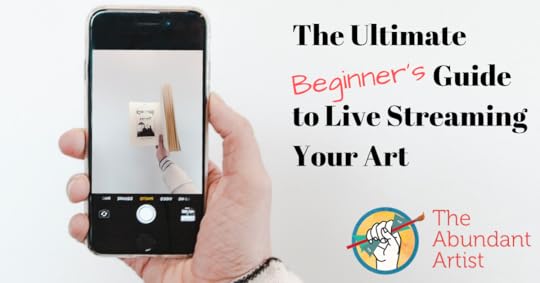
What is live streaming, and why is it so popular?
What is streaming, and why in the world is it such an enormous (and growing) medium? I have to admit that before I spent some time researching art streamers and watching their feeds, I was more likely to look down my nose at the notion of sitting idly watching somebody else do something in real time. But the more I watched, the more I understood the appeal. For one, watching artists who are experts at their craft is mesmerizing, relaxing, and extremely educational. But anyone can go watch old Bob Ross reruns if all they want to see is an excellent artist creating excellent work. What is different about watching it live?
A huge, and I would even argue primary, appeal of live streaming is the community aspect. In one live art stream I watched, there were over 2,000 live viewers, but only about 10 logged in Twitch members who were engaging in the chat. (This video is no longer available, but you can see a similar stream from the same artist here: https://www.twitch.tv/lilianaemmerling/video/461609308)
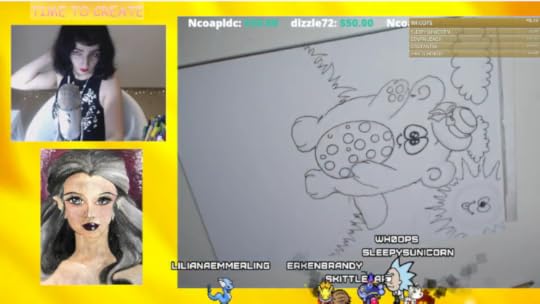
These members showed up on the stream as little avatars (known as “emotes” on Twitch) moving about the bottom of the screen. Occasionally they would input commands like !jump or !hug and interact with one another and with the streamer’s avatar. They would ask questions or make comments in the chat, and the artist would answer them in real time as she worked, calling out the viewers’ names and engaging with them in a warm manner that made it seem like they were friends. She spoke with a German accent in a soft ASMR-quality voice, and her appearance had about it a sort of casual and effortless glamor with dark brows and red lips. I could have sat in silence and simply watched her shade the hair of the woman in her drawing and banter with her viewers for hours. In the age of the gig economy, the side hustle, and the third and second job, when Millenials are hitting their 30s and have entered that phase of life where it’s nearly impossible to make real social plans, the ability to simply sit down at the computer and have instant fun, casual social interaction in real time centered around a shared interest is extremely appealing.
The friendly chatter of the viewers was a refreshing departure from YouTube comments, though I’m sure, thanks to the essential nature of humanity, that one wouldn’t have to dig too far into the live streaming world to find an exception.
Where are people streaming?
Live streaming is available on every major social platform. The top 5 platforms to find live streams are Twitch, Instagram TV, YouTube Live, Periscope, and Facebook Live. Twitter also allows live streaming, thought you’re more likely to find live news and media broadcasts there as opposed to enthusiast or creative streams.
We’ve compared and contrasted the main features of the different platforms so you can make the right choice for your art and your business.
Facebook Live
In order to stream via FB Live you will need a Facebook account. You can stream either from a personal page, a business page, or a group.
Equipment needed: A smartphone with the Facebook app, or a computer and a webcam.
Pros: Facebook Live is extremely simple to start using. On the desktop version all you need to do is start a new status update, and select “Live Video” from the icon menu.
Facebook Live has some neat broadcasting features, including selecting a specific audience or streaming directly to a group. You can also add a description to your feed (helpful for adding a brief explanation of what you’re doing or including your other social handles, website, etc). There are fun filters and themes you can superimpose over your video.
Facebook Live is a great way to stream “on the fly” or to share announcements, show off a finished piece, go live from an event, etc. If you create a closed group for Patreon supporters, for example, Facebook Live would be a great way to give those supporters exclusive content and not worry about anyone seeing it who isn’t supposed to.
Cons: Facebook Live is not the most helpful way to amass new followers. Your live broadcasts will be visible to your friends and followers (or the followers of your business page, depending on how you are using Facebook) or to the members of whatever group you broadcast to. It’s a little harder to find the “hub” of all live streams happening at a given moment, since live video isn’t Facebook’s primary focus. To find live streams, enter a search term like “art stream” in the search bar at the top of the page, then select “live” on the left hand side. As you can see from the screen shot of this search, some duds that don’t fit the search terms (including videos in foreign languages) pop up immediately. This is not the search feature art stream fans will use to find new content and new creators, so keep that in mind. If you’re looking to grow your audience, be sure to promote and cross-post your streams if possible.
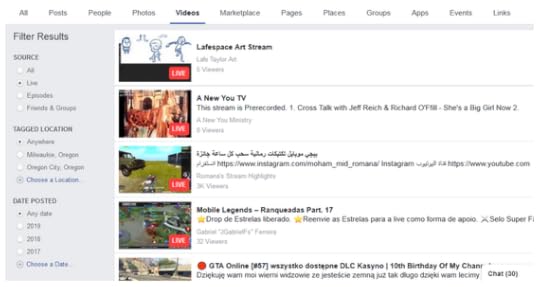
Who should stream on Facebook Live?
Stream on Facebook if that’s where your audience is.
Twitch
Twitch is a platform specifically for live streaming, so the functionality of this platform is a little different from the others mentioned here. In 2017, however, Twitch debuted a mobile app to allow for easy streaming directly from a mobile device without the use of third party apps.
Equipment needed: Streaming software (there are free options available such as Open Broadcast Software, often called OBS), a webcam, a low-mid end computer, and a microphone. The need for broadcasting software differentiates Twitch from other platforms, although there is a Twitch app for smartphones now, so you can still stream “on the fly” with a less complicated setup.
Pros: Twitch is a great place to go to discover new content and new creators to follow and support. Hit “Browse” and then search by category and tag. Categories include hundreds of video games, card and board games, puzzles (seriously), and so much more. There is a specific Creative category broken into smaller categories that include body art, food and drink, and art. The Art category has over 7,000 active viewers as I type this article on a Monday afternoon. There is tremendous potential here.
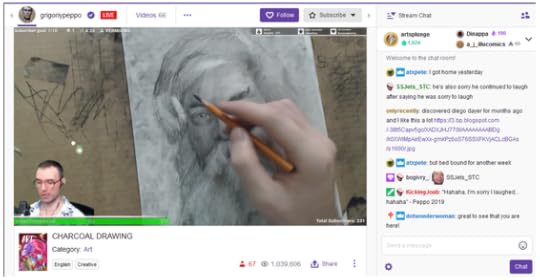
To that point, Twitch has worked very hard to cultivate a community atmosphere that is not present in the same manner on other platforms like FB Live and Instagram. The unique chat feature allows viewers to interact with the streamer in real time, as well as sometimes through an avatar on the screen. If you were live streaming yourself creating a painting or sculpture, you could invite viewers to ask you questions about your techniques, which you could answer in detail in real time as you perform the technique live. If you’ve never sat in on an art live stream, I highly recommend giving it a try. The pleasure of having the streamer respond directly to your question or comment as they work is uniquely fun, and can be an incredible way to build a base of rabid fans who adore you.
The Creative category is growing fast, but still only comprises about 1% of Twitch’s viewership (source), which means getting in now means getting in before the channel is oversaturated. There is a tremendous opportunity here for artists who want to build their audience off of more “traditional” social media, in a sector that is growing rapidly in size and popularity.
One of the most significant differences between Twitch and other streaming platforms is the ability to monetize the stream. There is a subscribe option by which your best fans can support you on a monthly basis, very similar to Patreon. Other viewers can still watch your streams for free, but subscribers get special perks like custom emotes (avatars) and ad-free viewing.
Cons: While the Creative category is growing, it is not Twitch’s bread and butter and so they may not support the channel in the same way as more popular gaming streams.
If you’re going to be working anyway and have the equipment necessary, why not start streaming? Post the links to the stream on your social media, play some music, go about your work, and chat with viewers when they arrive.
Who should live stream on Twitch?
Consider the type of art you’re making, and the audience most likely to search for new content on Twitch: if you are working digitally, drawing manga or art related to gaming or popular culture, or have any other kind of overlap with gaming or popular entertainment, give Twitch a try! This isn’t to say that more traditional fine art can’t succeed there, but you may have a leg up if you appeal to the fan base that already spends hours on Twitch every day.
IGTV
IGTV is Instagram’s answer to Twitch and YouTube, where users can create a channel and post their videos to it, including live streams. Unlike the other platforms, live videos do not remain on Instagram unless you save them and upload them back to your channel as a replay, or save them to your story.
Equipment needed: Instagram is a mobile-only app, so all videos are uploaded from your smartphone. The only exception to this is larger/verified accounts, who have the ability to upload longer videos from desktop. Most accounts will not have this capability.
Pros: IGTV as well as live streaming to your stories is a useful way to go live “on the fly”. Instagram is a very artist-friendly platform due to the overall emphasis on visual media, so you will find many, many artists streaming their work there. IGTV is different from recording videos and posting them to your feed or your story. If an IG user has a IGTV account, a small TV icon will show up on their profile between the photo grid icon and the “tagged in” icon. IGTV channels are typically used for longer videos.
Because of the nature of the way that live streams disappear 24 hours after they’re done, artists can leverage the sense of exclusivity to attract more viewers, and to create a sense of a once in a lifetime experience.
There is a chat feature on IG live streams, which allows for a fun interactive experience similar to Twitch.
Even though the IG algorithm has been known to hide your content from viewers, all new stories from everyone you follow appear at the top of the screen. So if you are utilizing stories to post live videos, you run a better chance of your audience seeing them than your regular content feed.
Cons: Creating a quality art stream on Instagram is a little more complex than simply recording yourself. Because you have to record from your smartphone in most cases, you’ll need a decent ltripod to get your phone at the correct angle and placement to record your work. So for a quality art stream, the equipment requirement is more than just a smartphone.
Who should live stream on Instagram?
Every artist with an Instagram account should give this a try. Instagram is a very artist-friendly platform, and when you start a live stream it will be visible at the top of every follower’s feed in the Stories bar. This ensures that even if your regular posts are being hidden by an algorithm, you can reach more of your followers with a live stream. Give it a try!
Periscope
Periscope is a live streaming app, similar to Twitch but meant more specifically for mobile. Once you’ve clicked through to a stream, the desktop site is very similar to Twitch. There is a search bar at the top that makes it very easy to find what you want.
What primarily differentiates Periscope from Twitch is Twitch’s greater emphasis on gaming in particular. Periscope is more balanced in the features and coverage of other topics and interests, which may be in your favor as an artist. Twitch, however, is more likely to have a greater pool of casual viewers interested in finding new content. Periscope is a useful live streaming tool that you’ll likely need to advertise to your audience on other platforms.
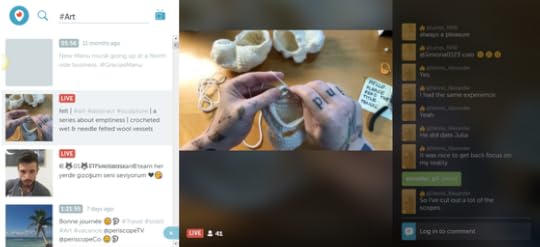
Equipment needed: Because Periscope is first and foremost a mobile app, you can stream from your mobile device. But just like the other platforms, if you want a high-quality art stream you’ll probably want to shell out for a tripod, at the very least.
Pros: The advantage of all push-button live streaming apps (Instagram, FB Live, Periscope) is portability, speed and convenience.
Cons: One very clear con, in my opinion, is an issue that I also saw with the Facebook live video search: when I did a search for “art” on Periscope, many of the first videos that popped up were in another language. It is unclear to me why there isn’t a language filter in the search application, and it makes it clear that it would be much harder for my art stream to be found if the website is not filtering the search results by world region. There may be a solution to this that I am not aware of, but it doesn’t inspire confidence for me that my content can be found easily on those sites.
Who should live stream on Periscope?
Periscope is a useful live streaming tool if you want to imitate the immersive, community-driven Twitch experience on a different platform. Don’t rely on Periscope to gain you new viewers, though. Periscope may be a good choice if you have an established audience elsewhere, or are using Patreon and would like to offer live streams to your patrons.
YouTube
Any channel in good standing has the ability to live stream on YouTube. There is also a “Live” channel you can subscribe to which is broken into categories, but at the time of this writing there is not yet an art or creative category.
You can create your own live stream page. Every time you stream, it will be to this same page.
Equipment needed: YouTube requires only a webcam or mobile device for live streaming, but it is also compatible with encoder software (software that digitizes your video for live streaming). This is helpful if you are using multiple cameras such as a face cam in addition to the camera trained on your work.
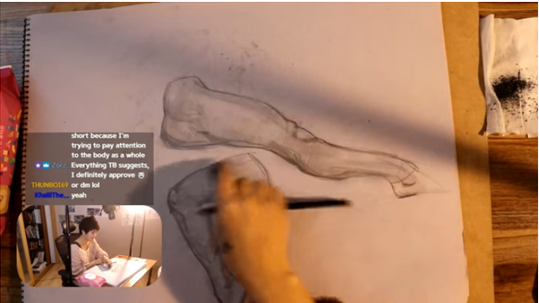
Pros: It’s easy to get started, with the ability to level up with more advanced hardware and software when you’re ready.
You can add live streaming to an already-established YouTube audience if you’ve already been posting videos to YouTube for a while and are ready to expand.
Cons: Why is there no art category on YouTube Live? There is gaming, news, sports, technology, and animals, but no creative category. This seems to be leaving out a massive opportunity to feature artists.
Who should live stream on YouTube?
Artists with an established channel on YouTube should definitely give live streaming a try. If you already have an established channel, it’s helpful to be able to keep your live streaming on the same platform as your other content rather than making your fans jump around from platform to platform.
How to get started live streaming your art
What basic equipment do I need to live stream my art?
While there is a deep rabbit hole of live streaming equipment you can travel down, to get started you do not need to spend hundreds (or thousands) on fancy hardware. Start with a smartphone and a tripod, or a good webcam. The webcam that comes pre-installed on many laptops is normally not of high-enough quality for live streaming purposes.
Webcams vs. smart phones
How do you decide whether you should use your smartphone or a webcam? This depends largely on the streaming platform and/or software you’re using. Smartphone broadcasting is great for a quick impromptu video, or recording outside of your studio and away from a proper setup. However, smartphone batteries will drain rapidly when live streaming, and will also be challenging to keep stable and avoid shaking. It’s also virtually impossible to setup a live stream of your art without a good tripod that you can attach to a surface at odd angles in order to get the right view of your work.
Try one of these webcams, all under $80:
*Logitech C920 ($67)
*Microsoft Lifecam HD-3000 ($25)
*Razor Kiyo ($79)
Lighting
You will also want to ensure that your lighting has eliminated all shadows on your art. Lighting quality is just as important as video quality, and if you have to choose between better video quality but worse lighting or great lighting with poorer video quality, you will want to prioritize lighting. Excellent lighting can redeem a lower quality webcam, but there’s not much you can do if all your great webcam is picking up is dark shadows. Bad lighting will be particularly frustrating for viewers of an art stream.
Lighting options include:
*Daylight bulbs
*Ring light (for even lighting)
Tripods
If you choose to use a smartphone or want to position your webcam in a different way, you’ll need a tripod. There are tons of innovative tripods made specifically for smartphones. Try one of these, all under $20:
*Manfrotto PIXI mini tripod kit ($19)
*Jelly Grip Tripod Mount ($17)
*Ubeesize Tripod S ($18)
Regardless of the streaming platform you choose, it’s fairly easy and accessible to simply jump in and begin streaming, and refine your equipment and techniques as you go. The barrier to entrance is very low.
Tips for a better streaming experience for your viewers
As you get into the swing of things, there are several ways to enhance the experience for your viewers. The simplest way to enhance the experience for everyone is to pay close attention to the chat and engage with your viewers! Some more ideas for a better streaming experience for everyone:
Invite your viewers to ask questions about your techniques, and answer them in real time.
Talk about the inspiration behind the piece, and about the reasons that you use the materials you do.
Hold your materials up in front of the camera and talk about brands, pigment names, etc.
Play music (there are options on platforms like Twitch to share that titles of the songs that are playing). Roy Laws is a TAA alumnus, and an artist who took the wonderful marriage of music and visual art to a new level with a fun collaboration (see his video in the section below.) A note about playing music on a live stream: playing copyrighted music can get you in big trouble. Check out Twitch’s rules on playing music in live streams: https://www.twitch.tv/p/legal/community-guidelines/music/
Set up a second camera that is trained on your face, so your viewers can watch you talk and see your expressions as you work. Some streamers make the face cam the primary image and relegate the art camera to a secondary view, and some do it the other way around. Here’s a great example of a face cam:
There is also the potential to do live online art shows to feature new collections and sell your art to collectors all over the world who may not be able to attend an in-person show. This would be especially effective after you’ve been live streaming for a while and have built up an audience who loves to watch you work. The multi-level marketing world has already gotten in on this opportunity on Facebook Live (raise your hand if you’ve ever been invited to a live Facebook “party” by a friend selling clothing, makeup, or food storage containers), but there’s a huge potential here for artists as well.
Who is streaming their art successfully?
We interviewed webcomic creator of Half of the Crown and freelance manga/anime style artist Rosalie Higashi to learn more about what it’s like to stream art on Instagram:
TAA: On what platform(s) do you live stream your art?
Rosalie: I mostly live stream on Instagram, as I feel the platform does a much better job of reaching the public eye and letting my followers know. Although owned by the same company, Facebook’s platform seems to limit visibility much more in an effort to get its users to pay for views, even moreso than Instagram.
I also record screen capture videos for my patrons on Patreon.
TAA: Why did you choose that particular platform?
Rosalie: I chose these particular platforms cause as a 2D artist, Instagram and patreon are very digital image focused, which makes it easier to deliver a product to a patron or a sneak peak of one of my pieces on Instagram.
TAA: Has live streaming made a significant impact on your business?
Rosalie: I would need to live stream more to see, but I believe it does help my business. To sell art is to sell an experience or a connection with a potential client and customer. Sometimes a customer wants to receive a copy of art done on live-streams as a way to commemorate watching the video, as watching can be an experience in itself.
TAA: Would you be willing to describe your setup? What equipment are you using?
Rosalie: If I live stream on Instagram, I use a cell phone tripod one of my followers sent to me as a gift. And if I upload a video on patreon, I use QuickTime on OS X to video capture, so the quality of the video capture is better than the cell phone video on instagram. My hope is that the patrons appreciate getting different, better quality videos. The only con to using QuickTime is that you can only video capture in 25 min increments or else it refuses to render the video for you.
TAA: What do you like about live streaming your art making? What do you wish was a little different?
Rosalie: I like that I can live stream and that the video is available for 24 hours for anyone who missed it the first time.
For an example of a fun live streaming session on YouTube that also featured live music, check out the video Live Guitar Painting with Don and Nash in Studio by TAA alumnus Roy Laws:
Live streaming opens up a wide range of opportunities to collaborate with other types of artists in ways that are not possible with other mediums.
It’s very likely that artists have yet to exhaust the innovative and creative possibilities made available with the advent of live streaming as a valid and increasingly popular medium. Ali Sabet is one example of an artist working on the cutting edge of what’s possible with live streaming technology. Check out this virtual reality doodling live stream Ali did using Oculus, a virtual reality gaming system:
As live streaming grows in dominance over other forms of online media, now is the time for artists to jump in before the various platforms become oversaturated. There are tremendous advantages and benefits unique to live streaming: developing and cultivating a close relationship with fans and collectors, engaging with an “in-person” feel with your face and your voice even though your collectors may be spread across the globe. Live streaming affords the ability to easily integrate a new dimension into online art courses and live art shows.
Although there are many ways to enhance the quality of your art stream, the barrier to entry into the world of live streaming is very low. With simply a smart phone or webcam and a well-lit corner of your studio, you can start live streaming on almost any social media platform in just a few minutes, surprising and delighting your fans and collectors.
What have you got to lose? Try live streaming your art today, and let us know how it goes!
*Asterisk denotes affiliate link
The post The Ultimate Beginner’s Guide to Live Streaming Your Art appeared first on Online Marketing for Artists.
August 12, 2019
Interview with Patrick Hall, from Fine Art to General Contractor (and Back)

In this episode:
00:45- How Patrick went from an MFA to opening a cabinet shop and working as a general contractor
7:09- How Patrick grew his design/build business
12:52- How working with fabricators and manufacturers has informed Patrick’s art-making methods
13:47- Patrick explains what “fabrication” means in the context of design/build work
19:10- How Patrick has made the transition from contracting to creating fine art clay pottery
21:49- How 2D art is different from 3D art, and the unique challenges of each type of work
24:09- Where Patrick is headed next with his art
27:40- Patrick describes the state of being “in the zone” that he reaches when working in clay
30:45- How Patrick learned to manage the logistics of a busy practice and business
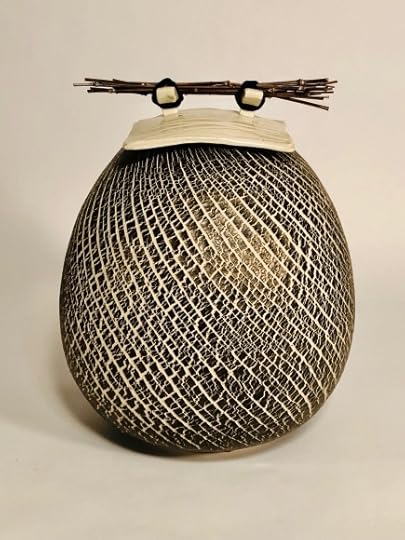 “Yogun Jar #13”
“Yogun Jar #13”
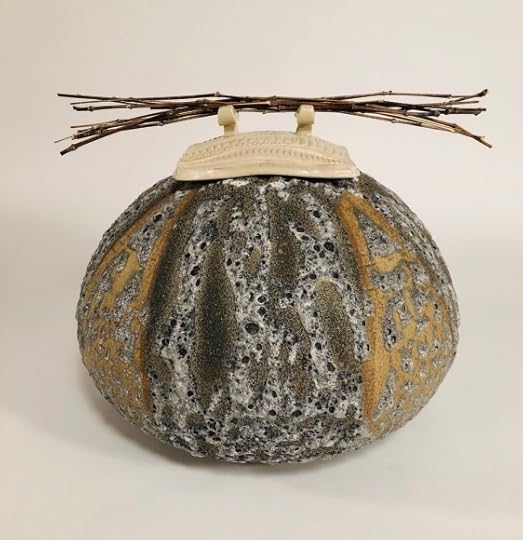 “Luna #3”, Patrick Hall
“Luna #3”, Patrick HallThe post Interview with Patrick Hall, from Fine Art to General Contractor (and Back) appeared first on Online Marketing for Artists.
July 22, 2019
How to Prepare for an Art Show
The artist blinks hard at the screen in front of her, gives her head a quick shake from side to side, and stretches her hands toward the ceiling. A few vertebrae crack as she leans into the stretch, and she rolls her head slowly from left to right. She’s been working on processing and editing a new series of photos for the past few days, and after a long morning in front of the computer screen she’s starting to feel cross eyed. She glances at the clock. She’s been at it since 8:00 a.m., and now it’s half past noon. Time to get away from the desk for a while before her eyes get stuck that way.
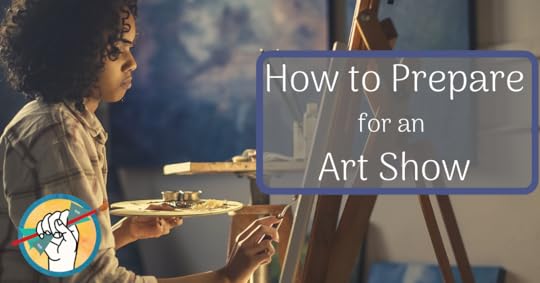
For the past several years, Hailey has been working as an artist full time. She was able to take the leap to full time work about five years after she settled into her personal flavor of abstract photography, about ten years after she first began pursuing photography as something more than a fun diversion. She is most commonly found outside in the dusky light of the sunrise and sunset hours, swinging her camera from side to side during exposure. With an eye for good lighting and skillful composition, she uses the unorthodox movement of the camera to tease the natural colors of nature together into evocative and lively abstract pieces that take the breathtaking natural beauty of the sky to a new level. One gets the idea when viewing her work that they can’t be quite sure what exactly it is they’re looking at, but it evokes deep feelings of peace and longing for nature just the same.
Hailey’s career reached its current state of buzzing busy-ness when she was featured in a regional art magazine. Through a combination of business smarts and a little luck she was able to leverage the attention from the magazine to get herself invited on a popular early morning talk show, followed by an appearance at her alma mater, where she had majored not in fine art but in communications (go figure.) She followed that up with a few talks at libraries and rotary clubs, and as July approaches and the organizations she has been relying on for new exposure go into a state of sleepy summer dormancy, she has begun to show at art fairs.
Hailey sits in a Mexican restaurant that evening with a fellow artist friend who has asked to pick her brain. She dabs a well-bitten fingernail against the salted rim of her margarita and touches it to her tongue and watches with amusement as the friend whips out a blank legal pad and demands to know how she does her “art show thing”. “I can’t seem to get myself organized! I don’t know how you do it! And also I’m a big chicken, because the idea of showing my art in the same place as a hundred other artists who are probably way better than me just scares me spitless. You have to tell me your secret. I’m taking notes.”
As she takes liberties with the salt shaker over a basket of warm tortilla chips, Hailey confides in her friend: “There is no secret. Showing your work will always be a little scary. And if you can figure out how to turn off the comparison thing in your brain forever, please let me know how you did it.
First of all, you need to determine whether your work is well suited to art shows. Can you display it easily? Will it be eye-catching from a distance, or can you arrange in a way that it is eye-catching? I have found over time that my work has more impact at large sizes, in person, so it works well for me to find new customers and new gallery accounts through shows. You know my photos look more like paintings, so it’s helpful to be there in person to explain and demonstrate my techniques to admirers. And, frankly, to avoid repeating “these are my photographs” about 200 times a day, because unless I make it really obvious, people don’t realize they are photographs. Once I say it, they are more intrigued by the art.
And every show doesn’t turn out great, to be honest. I still have a dud now and then. But doing your homework will take a lot of the scary guesswork out of the equation. When I first started doing art fairs, I started with a crap ton of research.”
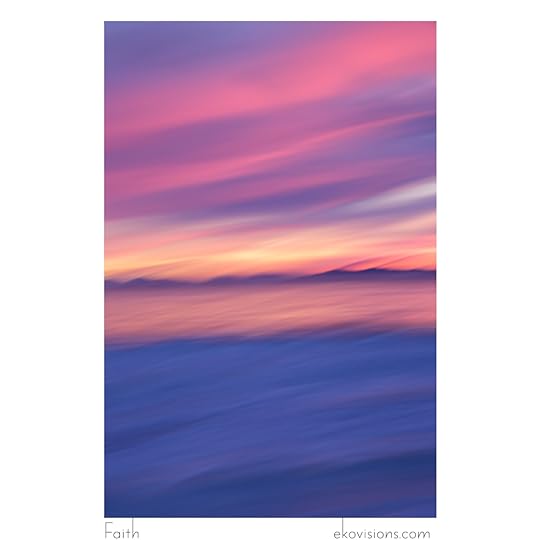
How to Research Art Shows
“The first thing I did was just do a simple Google search for summer art fairs in the area. I knew of one or two, but I have been so head-down the past couple years that I haven’t really been paying attention. I was surprised to find five art fairs and festivals within a 50 mile radius that seemed like they might match up with my work.
I made a spreadsheet (here’s a secret for you: I’m an artist, but there’s a tiny little accountant deep down inside my heart. I love spreadsheets.) Along the left hand side I included all five of the shows I wanted to research, and titled my columns like this: Location, Distance, Dates, Theme, Fees, Application Process, Reviews. There is a ton of information that I’m hoping to gather from these simple categories: can I afford to travel? Will my artwork fit in with the culture of the fair or show (like will it be appealing to visitors?) Can I even get my work accepted? Is it a good event that’s likely to be worth my time and money? After having done this for a while, I’ve determined that I only do indoor shows or outdoor shows in large tents. I’ve seen too many horror stories about weather so I mostly stay away from the outside stuff. I’m also generally looking for higher-end shows focused on art. There’s nothing wrong with fairs that feature music and kid events, but that isn’t where my audience is.
Download our free Art Show Research Spreadsheet in the Free Member Library!
When I was first researching, it took me a couple hours of research to get my spreadsheet mostly filled out. I really love when an art fair has a really well fleshed-out and informative website! It generates a ton of confidence for me in the overall efficiency of the organization producing the event. I had to make a couple of phone calls and send a couple of emails to track down the answers for the fairs that didn’t have great websites, which sucks since it’s 2019 and everyone has social anxiety now. Nevertheless, I did what must be done. Then I took to Google again to try to find some reviews and testimonials.
I took my time with this part, because I was trying to find reviews from artists who have done the shows in years past as well as actual visitors. I think it’s really important to get both perspectives to provide a full picture of what the event is like, particularly if it’s one you’ve never been to. If you think you’re ready to start applying to shows, you should start going to shows! You’ll be surprised how much you’ll learn just by observing.
So I started Googling “name of the show + review.” What I found was that Yelp was really helpful for this! Even though most of the reviews are generally from visitors to the shows rather than exhibiting artists, there is a ton of information that you can glean from those reviews. In visitor reviews I look for a couple of things as a helpful barometer of the overall success of the show.
I search the reviews for indicators that:
The show is well advertised and an overall good value for visitors
Visitors intend to return after their first visit
There are photos from past years
The event is well-run including easy transactions for customers, good signage, and well-staffed
One popular summer arts festival apparently had a … fiasco with the portable restroom facilities a few years back that garnered a lot of negative reviews across the board, but it looked like a standalone incident. Actually, it was really encouraging for me to see that the social media people for the event were on it, and they were responding to negative reviews with a lot of empathy and good humor. Any event run by human beings is going to eventually experience a snafu, so what’s more important is how the staff responds. That gives a good indicator of how you’re likely to be treated as an exhibiting artist. So I keep that in mind as I search for reviews.
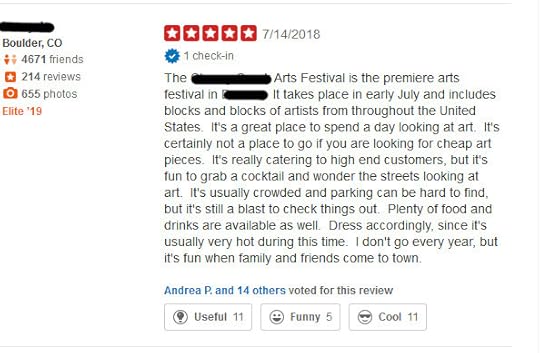
When I’m researching shows, I also pay really close attention to signs that something may not be quite right. When I’m reading reviews, I’m looking for:
Reviews that express surprise at the reality of the show in contrast with the way the show was advertised
Warnings from multiple past exhibitors to stay away
When I was first researching shows, I did this homework for the top 5 shows in the region that seemed to match what I was looking for. I cross checked the reviews with any advertising I could find to try to determine whether the show is delivering on promises to both visitors and exhibitors. This process took me a couple of weeks. I may have been slightly obsessive about it, but when I’m laying down my hard earned cash to exhibit in a show I can’t really afford to make a serious mistake.
At that point I did eliminate one show from the lineup just based on the abundance of negative feedback from both visitors and exhibitors. Then I looked to the remaining four to assess the cost and decide whether I could even afford to apply for it.
Can I Afford to Join that Art Show?
After I’ve compiled my review research, I start to search the websites for the shows themselves. I’m looking for very specific information about the costs associated with exhibiting:
Where is the show located? (i.e. will I need to pay for travel and lodging?) I eliminated one more show based on distance. I just didn’t have any budget for lodging the first go around. Now that I’m more experienced with shows and have been doing this for a few years, I’ll travel a little. But at a bare minimum, I need to cover the booth fees and travel expenses. When determining the success of a show, remember that it’s important to be patient. This is something early-career artists tend to forget. Sometimes orders come in for shows months later. For me this is especially for my large canvas prints, which people tend to buy when they’re redecorating. Other times, the real value of the show is in the people I meet. I found a new gallery on Martha’s Vineyard to carry my work at a show in the spring! That is hopefully going to pay dividends for me down the line, so it’s helpful to take a long-term look at the overall value of a show. (For more on making the most of an art show, check out our interview with Owen Garratt: What a $1 Million Art Business Looks Like)
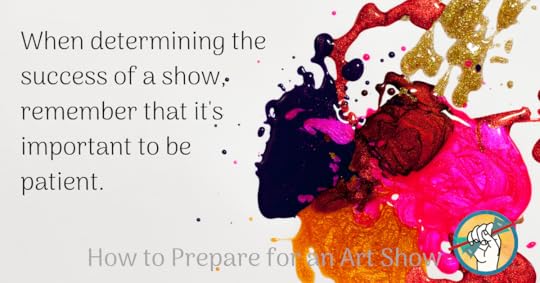
Other questions I ask about cost:
How much does it cost to apply?
How much does it cost to register (booth fee)?
Which booth materials are provided and which are not? Do I need to provide my own tables/chairs, how is electricity supplied, etc?
One of the shows I was really interested in that first year actually ended up being a juried show with a sort of outrageous registration fee, if you can even get in. That will be my dream show to try to get into a few years from now. So after I researched cost, I was down to two shows, both outdoor art fairs taking place during the summer. I decided to go ahead and apply for both of them.
How to Prepare for an Art Show
In order to prepare for the show, I need to ensure that the work I’m showing is in a coherent series. This isn’t an issue for me because of the way I work now, but when I was first discovering my style I was kind of all over the place. I had produced a ton of work, but there was no clear thematic thread. The style was there, but you couldn’t look at my work and understand that this was a sunset series, this was an ocean series, or anything like that. So I worked really hard to put together a memorable completed series that I could show.
Getting your work ready takes quite a bit of effort, especially the first time you do a show. Large canvas prints do the best for me at shows. The large impact pieces are really the show-stoppers that get people into the booth; I try to make sure to have a backup or two. If those sell, and I have no replacements, I find that traffic to my booth dies down. I usually carry large canvas prints (up to 32″ x 48″ with a float frame, that retail for $1275) and can order different sizes or images for people. I also have small matted and framed prints, at 12″ x 16″ and 18″x 24″.
I also made a set of meditation cards, which is basically a small portable art collection. I sell those as an entry-level item, usually running those on special at $23 at the shows. Probably the most useful thing I have is my moo business cards–they each have an image on the back, so if people are eyeing a piece but on their way out, I’ll try to hand them the business card with that specific image. Best way to ensure they remember what they were looking at.
Preparing my meditation cards, large canvas prints, and business cards is a process I need to start several weeks in advance of a show to make sure that I get everything in time. If I end up ordering much more than I would normally keep in stock, then I add those expenses to the total cost of the show. This helps inform my decisions for future shows.
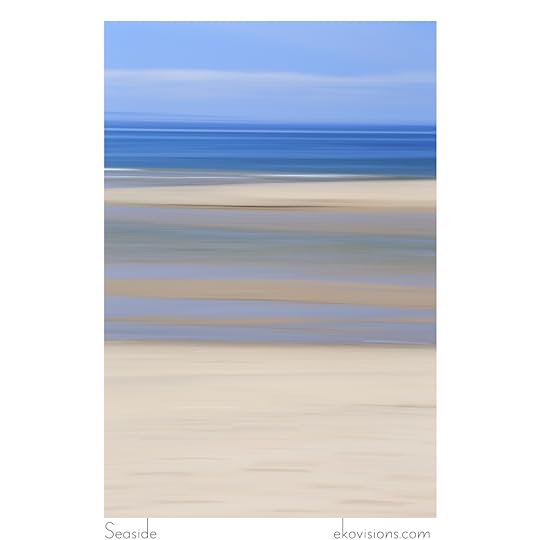
Prepare to Follow-Up After the Art Show
This is something that a lot of first-timers don’t think about beforehand, I know I didn’t. But this step is vital to your success. A huge amount of sales happen in the weeks and months after a show, and the way that I prepare to be successful here is by getting my email marketing sequence ready to go.
I like to create a special welcome email especially for people who sign up for my mailing list at the show. In the first email I’ll pop in some photos from the show, and a special thank you for visiting my booth. If I can, I try to feature a couple of testimonials and pictures of people who bought my work while at the show, and maybe even throw in a little scarcity message, like “After selling three of these large canvas prints at the show I only have two left in stock. These go fast!”
Those emails then go directly into my regular nurture sequence, where I keep in contact with them on a regular basis to keep my name at the front of their mind.
If any potential customers expressed special interest in a certain piece or in a commission, I’ll email them directly to thank them for visiting my booth, very gently remind them of what they were interested in and just generally let them know that I remember who they are and want to stay connected. I also send these kinds of emails to other artists and organizations that I make contact with at the shows. Networking is such an important part of this job. I used to be really shy about it, but I spent some time studying sales, body language, and active listening. I may get a little nervous now, but talking to potential collectors and business partners with confidence gets a little easier every time.
When I’m preparing for a show I also review some of the basics of selling in person: how to use body language to inspire confidence, active listening, and rehearsing my “elevator pitch”, so to speak, or my unique value proposition. Since I spend so much time making and editing my art in solitude, I don’t really trust myself to have the sales skills ready to go unless I brush up on them right before a show. Knowing that there are specific things I can do to increase my confidence and my likeability helps me feel a lot less nervous about the selling part.”
Keep Learning and Experimenting
As Hailey signs the receipt at the end of their meal, she smiles at her friend, who is still furiously scribbling notes on her pad with a furrowed brow. “This is a crazy amount of work,” her friend mumbles. “Yeah, it’s crazy. You should actually be spending at least half of your time on marketing and business,” Haily responds. “It took me a while to get to the point where I was spending half of each day on business, but once things started picking up I realized that I truly needed all of that time, if not more. It’s a ton of work up front, and everything I told you is good advice from me, but you should also do your own thing. I did a lot of experimenting, failing, and learning before I found what works for me. I’m sure there will be different things that work for you. Your work will probably fit into different shows than mine, and you’re selling at a different price point. So what you need to do is just get started. Keep obsessively close track of your expenses, practice asking for the sale, and just get out there and start showing your art!”
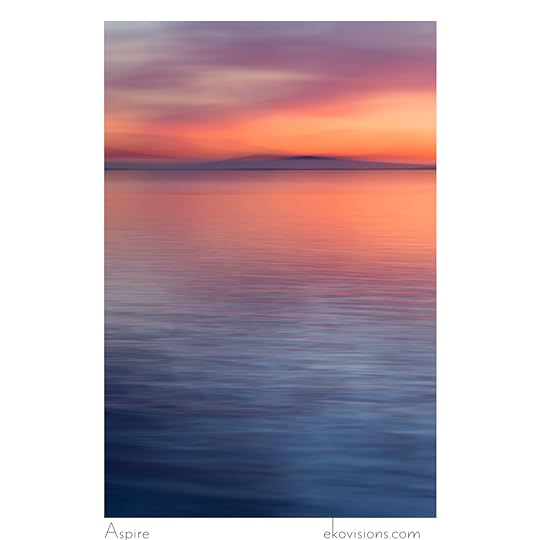
The artist in this piece is fictional, but she is partially based on real-life artist Kelly O’Neal . Kelly was generous enough to answer several questions for us, which we incorporated into this blog post. The full interview is below.
TAA: What are the top 3 reasons you exhibit in art shows?
Kelly: I find my work has more impact at large sizes, in person. I find new customers and also new gallery accounts through shows. Because my photographs look more like paintings, it is helpful to be there in person to explain and demonstrate my technique to admirers. And, frankly, to repeat “these are my photographs” about 200x a day, because unless I make it really obvious, people don’t realize they are photographs. Once I say it they are more intrigued by the art.
TAA: What criteria do you use to select which shows you attend?
Kelly: I only do indoor shows or those in large tents; I’ve seen too many horror stories about weather and have no desire to deal with that. I’m generally looking for higher-end shows focused on art–not those that are more festivals with music or kid events. Proximity to home is helpful too–I’m not doing a huge circuit right now, so I prefer to do something within about a 4 hour drive.
TAA: How do you prepare your work for a show? Do you do anything special to package/present your originals, do you make prints or promo materials with your work on it, do you make other art gifts or merch?
Kelly: Large canvas prints do the best for me at shows–note all my work is photography, so I don’t really have “originals.” The large impact pieces are really the show-stoppers that get people into the booth; I try to make sure to have a back up or two. If those sell, and I have no replacements, I’ll find that traffic to the booth dies down. I usually carry large canvas prints (up to 32″ x 48″ with a float frame, that retail for $1275) and can order different sizes or images for people. I also have small matted and framed prints, at 12″ x 16″ and 18″x 24″. My meditation card set is a small portable art collection that I sell as an entry-level item, usually running those on special at $23 at the shows.
Probably the most useful thing I have is my moo business cards–they each have an image on the back, so if people are eyeing a piece but on their way out, I’ll try to hand them the business card with that specific image. Best way to ensure they remember what they were looking at.
TAA: How do you prepare your business for a show? Do you use email marketing to connect with interested collectors, and/or to let people know you have a show coming up? What do you do on social media before a show?
Kelly: Honestly, I need to do more with this. I will generally announce it to my mailing list a week or so out, plus mention it on my Instagram Stories and on my Insta and Facebook Feeds. I’ll tease new work I might be showing for the first time in person there. The best shows, if you tag them in your posts, will share them with their audience–which can be a huge win if people are then seeking you out. It also helps to build the relationship with show organizers.
TAA: What are the 3 most important factors that determine your success at a show? Which can you control, which can’t you control?
Kelly: It’s such a crapshoot, honestly. Some shows where I’ve done well, nearby vendors with good work have sold literally nothing. I think the biggest thing I can control is to be sure my work is a good fit for the show and that I have a good mix of large pieces to draw people into the booth. Plus signage that helps people understand that this is photography.
Weather is unfortunately a huge factor–you want it nice enough for people to go out, but not so nice that they just go play at the beach. And too hot will just kill the show unless it’s inside with AC. I think finding the right balance between being friendly and letting people contemplate to themselves is critical! So many people get really pushy, and it seems to push people away. My favorite trick is to be busy re-stocking or re-arranging work; my busy-ness seems to give people permission to look and my booth gets more crowded, seriously.
TAA: What do you do after a show to follow up with potential collectors? What does networking look like for you at art shows?
Kelly: I keep a list of everyone who needs personal emails, including people who have sent me pictures of their rooms for me to recommend sizes and picture combinations. Plus I’ll add people to my email list, and try to follow-up shortly thereafter so they remember who I am.
TAA: How do you determine whether or not a show was successful for your business?
Kelly: At a bare minimum, I need to cover the booth fees and travel expenses. I do think it’s important to be patient, though–sometimes orders come in for shows months later, especially for my large canvas prints which people tend to buy as decor pieces when they are redecorating. Plus sometimes the value of the show is in the people I meet–I found a new gallery on Martha’s Vineyard to carry my work at a show in March, for example.
One other thing I’ll add: my favorite thing to do during shows is keep a log with the time & note on things happening–compliments, interesting quotes, everything. This helps keep me focused on the longer game when sales are slow. Example from a recent show: “1:00: “If I had that in my living room, I’d be peaceful all the time.”
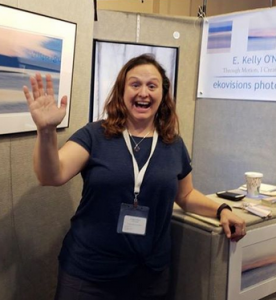 Kelly O’Neal is madly in love with abstract photography, travel, sunsets, quiet, chocolate, and her dog Teddy Bear, who also serves as her mostly enthusiastic photographic assistant. She is a fine art nature photographer. These days her focus is on creating abstract images through camera movement–panning, wiggling, turning, and swooshing the camera during exposure. Sound weird? It is. But also amazingly fun with beautiful results. See more of Kelly’s work at http://ekovisions.com
Kelly O’Neal is madly in love with abstract photography, travel, sunsets, quiet, chocolate, and her dog Teddy Bear, who also serves as her mostly enthusiastic photographic assistant. She is a fine art nature photographer. These days her focus is on creating abstract images through camera movement–panning, wiggling, turning, and swooshing the camera during exposure. Sound weird? It is. But also amazingly fun with beautiful results. See more of Kelly’s work at http://ekovisions.com
The post How to Prepare for an Art Show appeared first on Online Marketing for Artists.
The Abundant Artist Goodreads blog
- Cory Huff's profile
- 31 followers



